Changing History to HERstory: Radical Writers
Planned as an in-person exhibition, Changing History to HERstory had to go online due to Covid restrictions and quicky became an internet success - and then a book, which you can buy here!
In a world still heavily influenced and controlled by men, history remains dominated by the male perspective and narrative. Kat Shaw decided that for International Women's Day 2021, she would focus on the women who made a difference - many of whom are not always acknowledged and celebrated today. She wanted to change history to HERstory, raising the profiles of these brave and determined women and giving them the recognition they have deserved for many years!
To read about the achievements and struggles of all of Kat's muses alongside the art they inspired, follow the links from this project's Exhibition Page. Below, you can read about the writers whose lives and words of wisdom inspired her.
“Never trade in your authenticity for safety.”
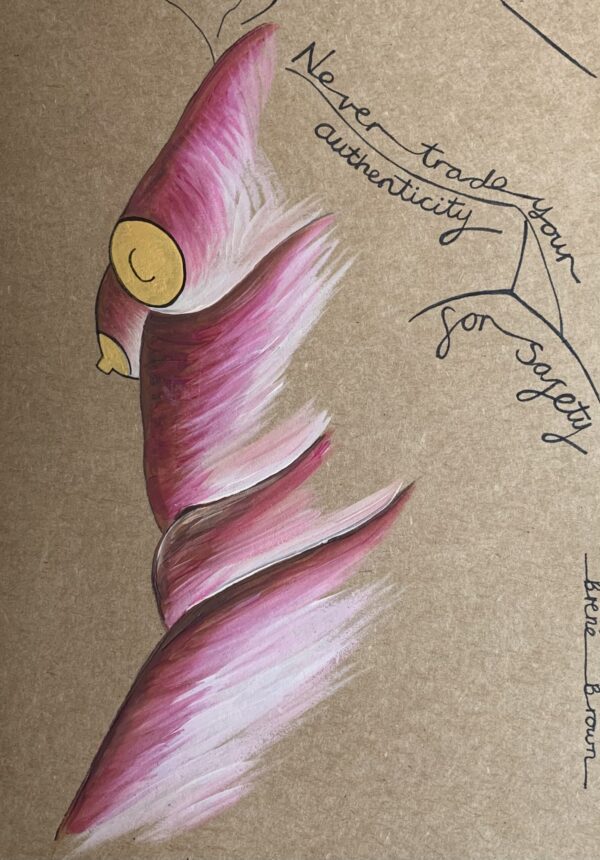
Brené Brown
Brené Brown (born November 1965) is an American professor, researcher, lecturer, podcaster and author. Currently, she holds an Endowed Chair at the University of Houston's Graduate College of Social Work. She is also a visiting professor of management at McCombs School of Business at the University of Texas.
Brown has studied courage, shame, empathy, vulnerability and leadership for two decades, building a highly successful career. Her 2010 talk, The Power of Vulnerability, is in the top five most-viewed TED talks. She has now officially gone 'mainstream', and is the author of five number-one New York Times bestsellers.
She says: “I believe that you have to walk through vulnerability to get to courage, therefore . . . embrace the suck. I try to be grateful every day and my motto right now is, 'Courage over comfort.' I do NOT believe that cussing and praying are mutually exclusive, and, I absolutely believe that the passing lane is for passing only.”
“If you trade in your authenticity for safety, you may experience the following: anxiety, depression, addiction, rage, blame, resentment and inexplicable grief.”
“Sometimes the bravest and most important thing you can do is just show up.”

“If you’re not in the arena also getting your ass kicked, I’m not interested in your feedback.”
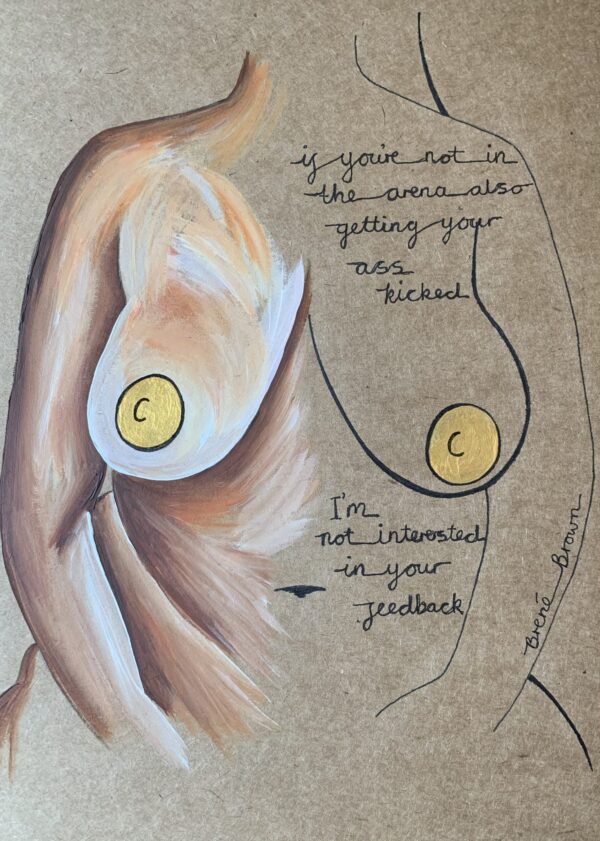
“Let go of who you think you’re supposed to be; embrace who you are.”
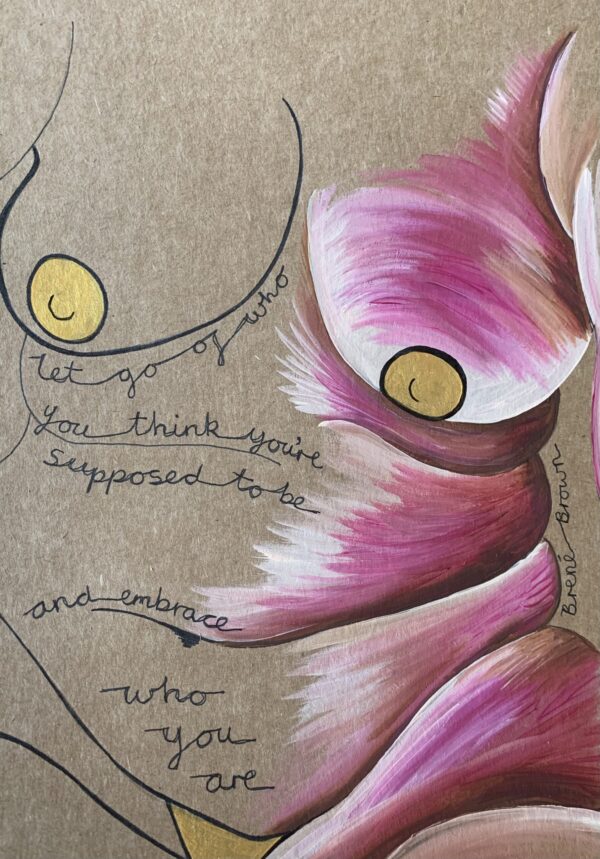
“I am both war and woman and you can't stop me."
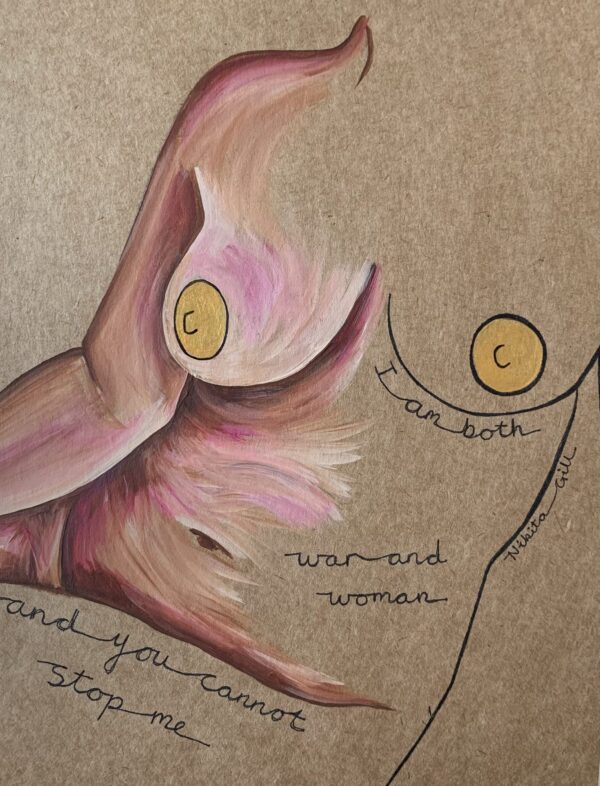
Nikita Gill
An Ode to Fearless Women
“Defined by no man, you are your own story.
Blazing through the world, turning history into herstory.
And when they dare to tell you about all the things you cannot be, you smile and tell them,
I am both war and woman and you cannot stop me.”
Nikita Gill, a poet and writer, grew up in Gurugram, Haryana in India. In her mid-twenties, she emigrated to the south of England. She worked as a carer for many years but has been writing for as long as she can remember. At 12 years old, a non-fiction story she wrote was published in a newspaper in India and she started sharing her poetry on Tumblr ten years ago.
“You are your own story.”
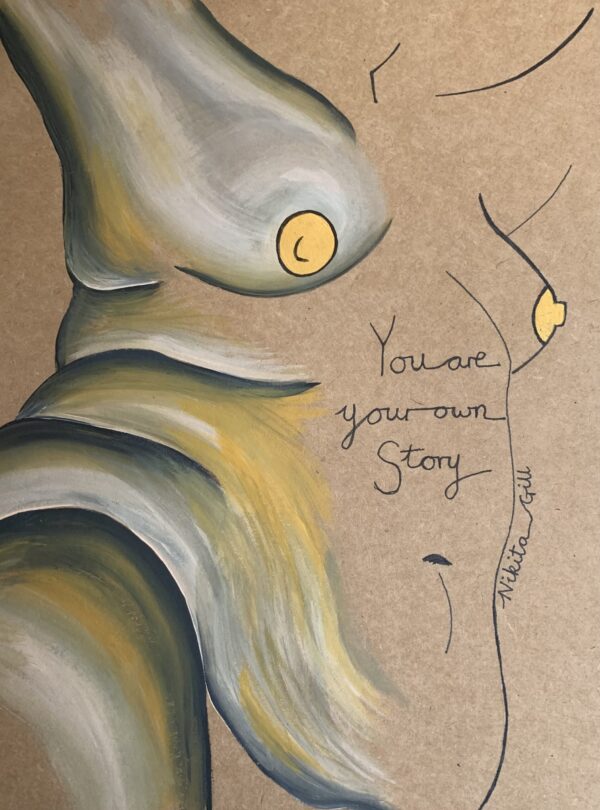
Gill’s first manuscript was rejected by 137 publishers, and she used it as fuel to better her creative process – and that certainly happened as she has published many books since then! She has a very modern view of the ever-changing world of social media and how poetry plays into it.
She is vocal in her advocacy for poets and their right to be credited correctly for their work; Gill herself has experienced celebrities, such as Khloe Kardashian, using her work without crediting her. She longs to educate people about personal responsibility within the arts.
In Gill's book, Fierce Fairytales: & Other Stories to Stir Your Soul, she takes classic tales and gives them a fun, feminist twist. Gones are the aged tropes, cliches and damsels in distress just waiting for knights in shining armour to save them. Cinderella becomes a princess who can save herself, Little Red Riding Hood is a leader of wolves, and villains might just be misunderstood - and relatable characters.
Gill is an Instagram sensation, and it's amazing to see such a strong woman writing HERstory and inspiring others along the way.
Germaine Greer
Germaine Greer, born 29th January 1939, is an Australian writer and public intellectual, regarded as one of the major voices of the radical feminist movement in the latter half of the 20th century.
Her radical feminist views, and her book, The Female Eunuch, published in 1970, was pivotal in post-second-wave feminism literature. Her book explores the behaviours of women, and became a bestseller around the world, making Greer a household name.
Her thesis is that the 'traditional' suburban, consumerist, nuclear family represses women sexually, and that this devitalises them, rendering them eunuchs. Greer is a liberation (or radical) rather than equality feminist and her goal is not equality with men, yet it favours women. Her beliefs are controversial, but she believes that arguments and conflicting views need to be heard to be refuted, and says that she isn't afraid of criticism.
In a 2019 interview with the BBC to mark her 80th birthday, she said, "That’s the point of writing anything, is to get criticised. I’m not going to go home and cry because you disagree with me.” There is no denying the fact that she has definitely written HERstory in her own way!
The full quote that inspired the painting is, “Freedom is fragile and must be protected. To sacrifice it, even as a temporary measure, is to betray it.”
“Freedom is fragile and must be protected.”
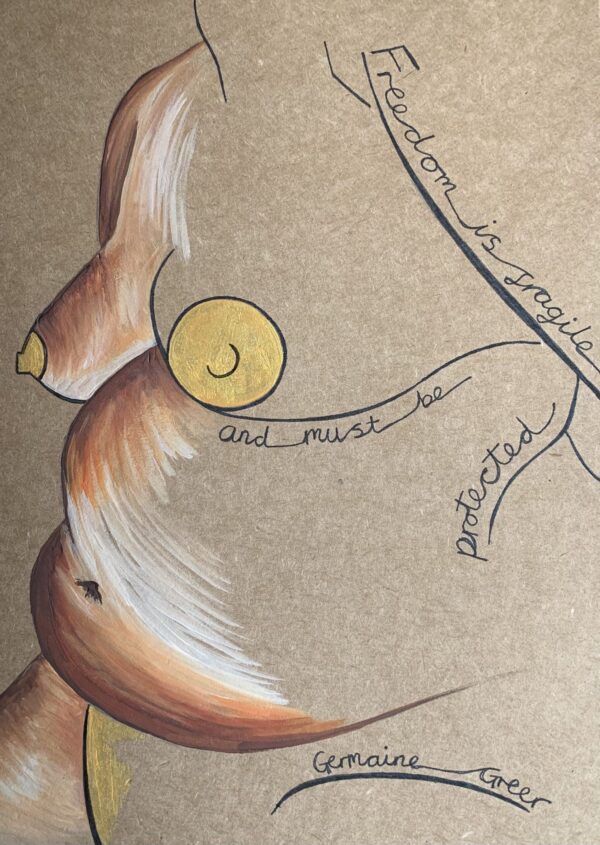
"You alone are enough."
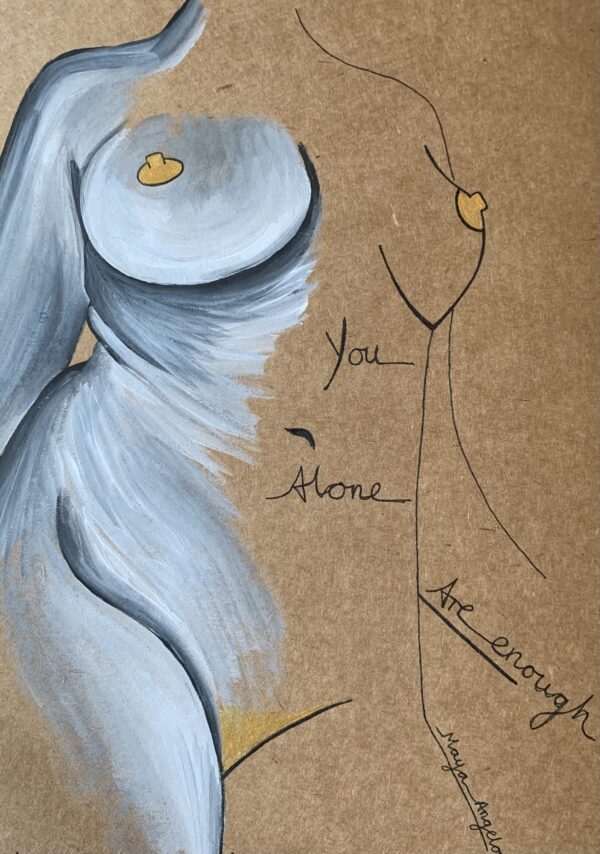
When she was 8 years old, Maya Angelou stopped speaking. She silenced her voice because she thought her voice had killed a man and for almost five years, she spoke to no one but her beloved brother, Bailey. The man she believed she had killed with her voice - her mother's boyfriend, Mr. Freeman - had raped her. After she testified against him in his trial, he was convicted and sentenced, but released from jail.
Four days later, he was found dead. Murdered. Probably by Angelou's uncles, her memoir implies.
Angelou told this story in her first book, "I Know Why the Caged Bird Sings," her groundbreaking memoir about her childhood. Published in 1969, when she was 41 years old, the book established her voice – the one she had silenced as a child - as one of the most important in American literature.
Angelou's work takes readers on a personal journey through the African American experience of the 20th century. She writes with blazing honesty about racism, rape, her pregnancy at 16 and the deep fractures in her own family.
Her strong voice speaks to countless readers as her themes of finding identity, strength, economic, racial, and sexual oppression and courage carry deep resonance. Besides writing about racial inequality, Angelou wrote many empowering poems about women and their rights; she wrote about the hypocrisy of the world, and injustice, but also about love and nature.
Maya Angelou
Maya Angelou (1928 – 2014) was an amazing woman with an incredible life story. She was an American poet, memoirist, and civil rights activist. She published seven autobiographies, three books of essays, several poetry books, and is credited with a list of plays, movies, and television shows spanning over 50 years. She received dozens of awards and more than 50 honorary degrees.
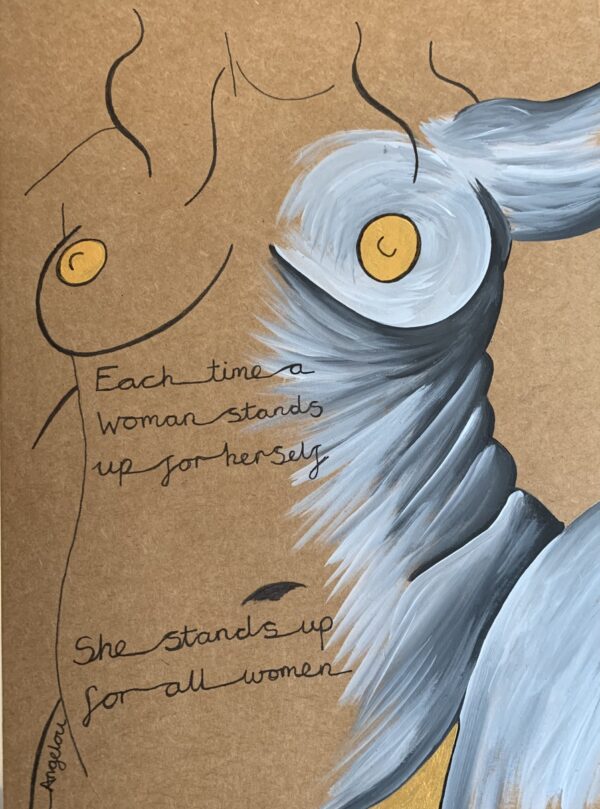
"Each time a woman stands up for herself, she stands up for all women.”
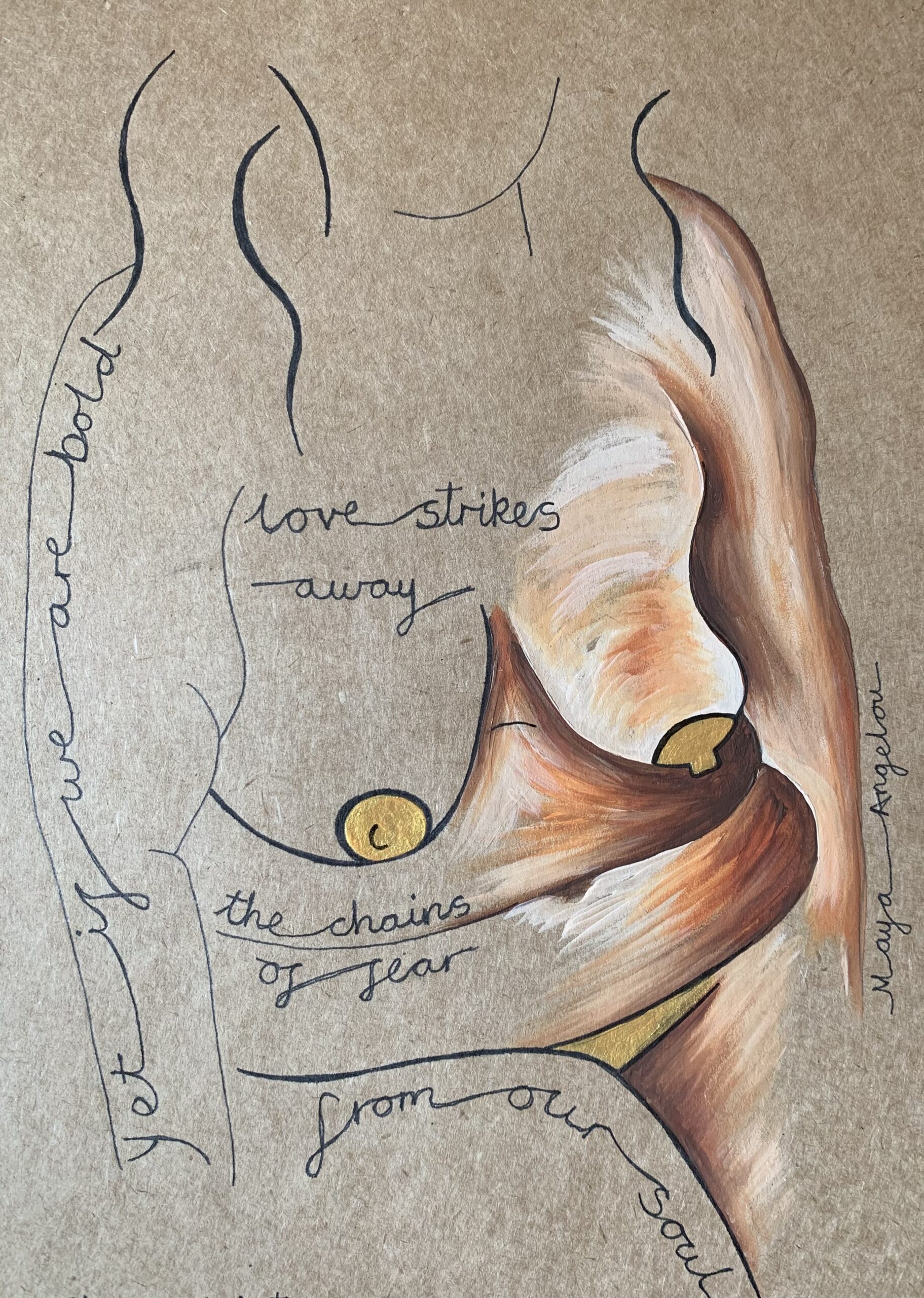
“Yet if we are bold, love strikes away the chains of fear from our souls.”
“I’ve got my own back.”
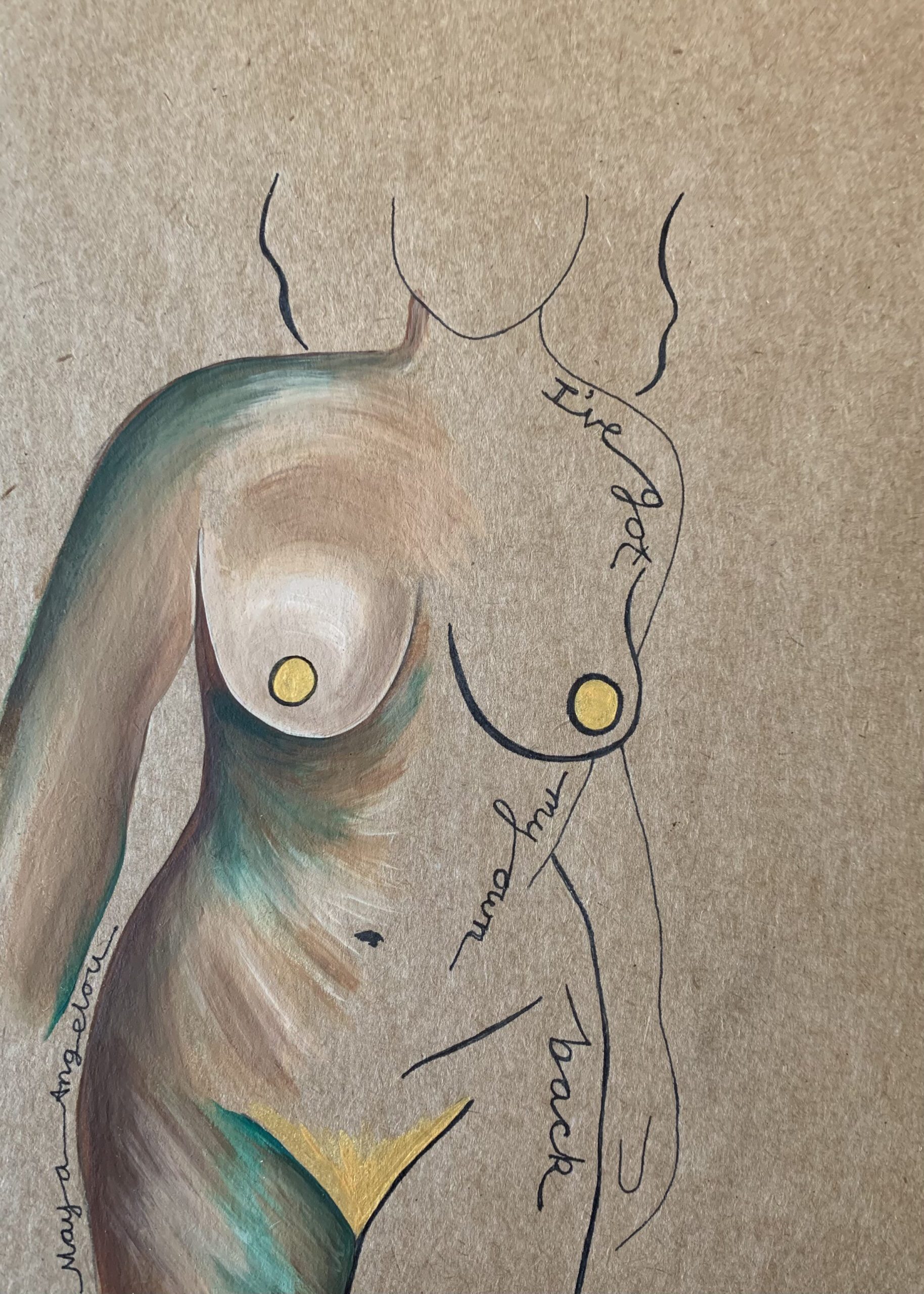
Her work and her life offer readers a personal journey through the African American experience of the 20th century, writing with blazing honesty about racism, rape, her pregnancy at 16 and the deep fractures in her own family. Her strong voice speaks to countless readers as her themes of finding identity, strength, economic, racial, and sexual oppression and courage carry deep resonance. Besides writing of racial inequality, Angelou wrote many empowering poems about women and their rights; she wrote about the hypocrisy of the world, and injustice, but also about love and nature.
“Touched by an angel”
“We, unaccustomed to courage
exiles from delight
live coiled in shells of loneliness
until love leaves its high holy temple
and comes into our sight
to liberate us into life.
Love arrives
and in its train come ecstasies
old memories of pleasure
ancient histories of pain.
Yet if we are bold,
love strikes away the chains of fear
from our souls.
We are weaned from our timidity
In the flush of love's light
we dare be brave
And suddenly we see
that love costs all we are
and will ever be.
Yet it is only love
which sets us free.”
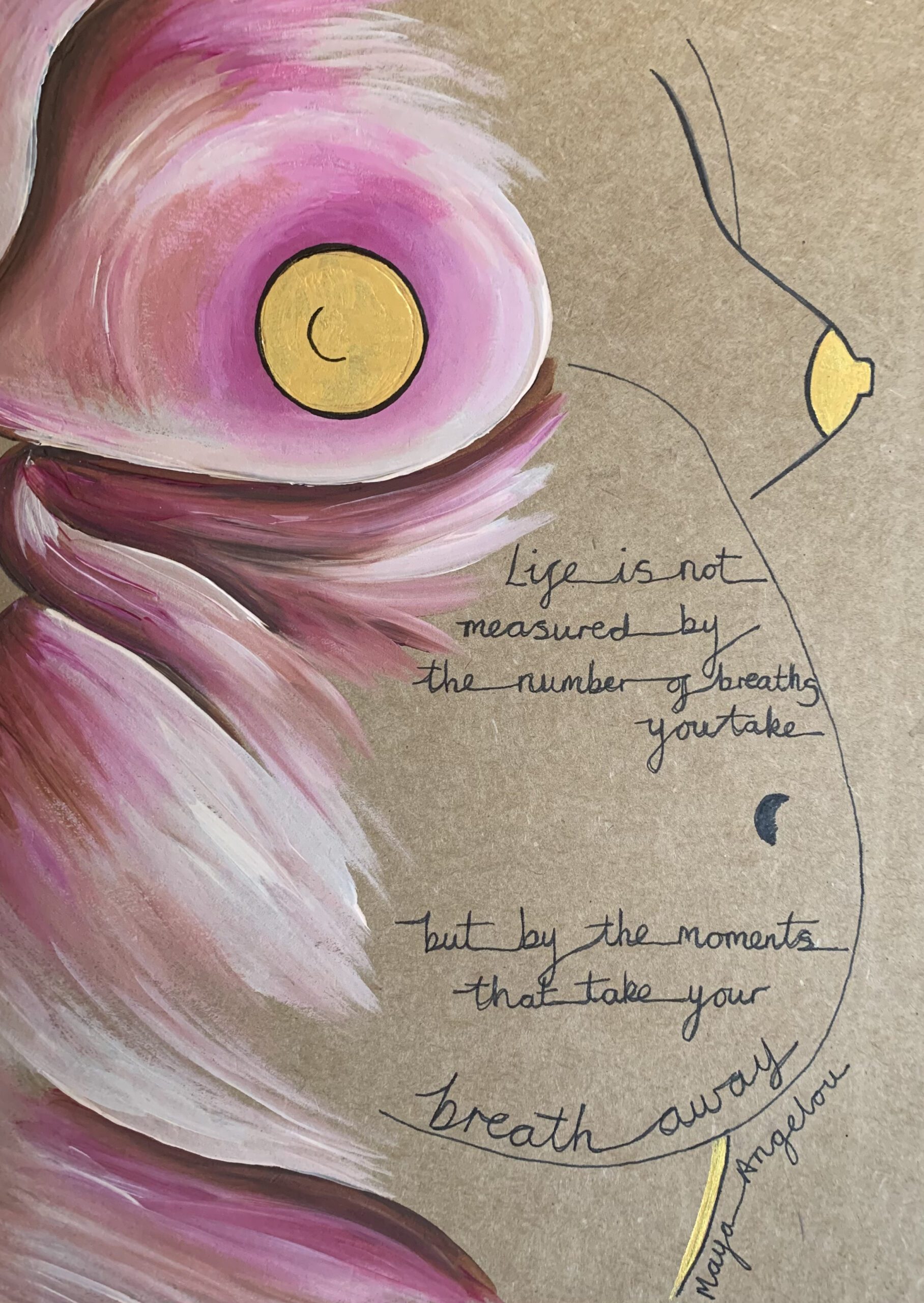
“Life is not measured by the number of breaths you take, but by the moments that take your breath away.”
One of Angelou’s most famous poems is Phenomenal Woman.
In this poem, Angelou speaks out about the dignity of being a woman, about self-pride and female grace. It is about sex appeal, about the inner power that radiates through in an inexplicable way. This kind of strength has nothing to do with a dress size or other beauty standards imposed on women: it has a deeper meaning, as it is connected to one’s identity.
A woman is therefore not only beautiful (as beautiful is something that is usually linked to outer beauty), but also phenomenal:
“It’s the fire in my eyes,
And the flash of my teeth,
The swing in my waist,
And the joy in my feet.
I’m a woman
Phenomenally.
Phenomenal woman,
That’s me.”

“If you’re always trying to be normal, you’ll never know how amazing you can be.”
“Aging is not lost youth but a new stage of opportunity and strength.”
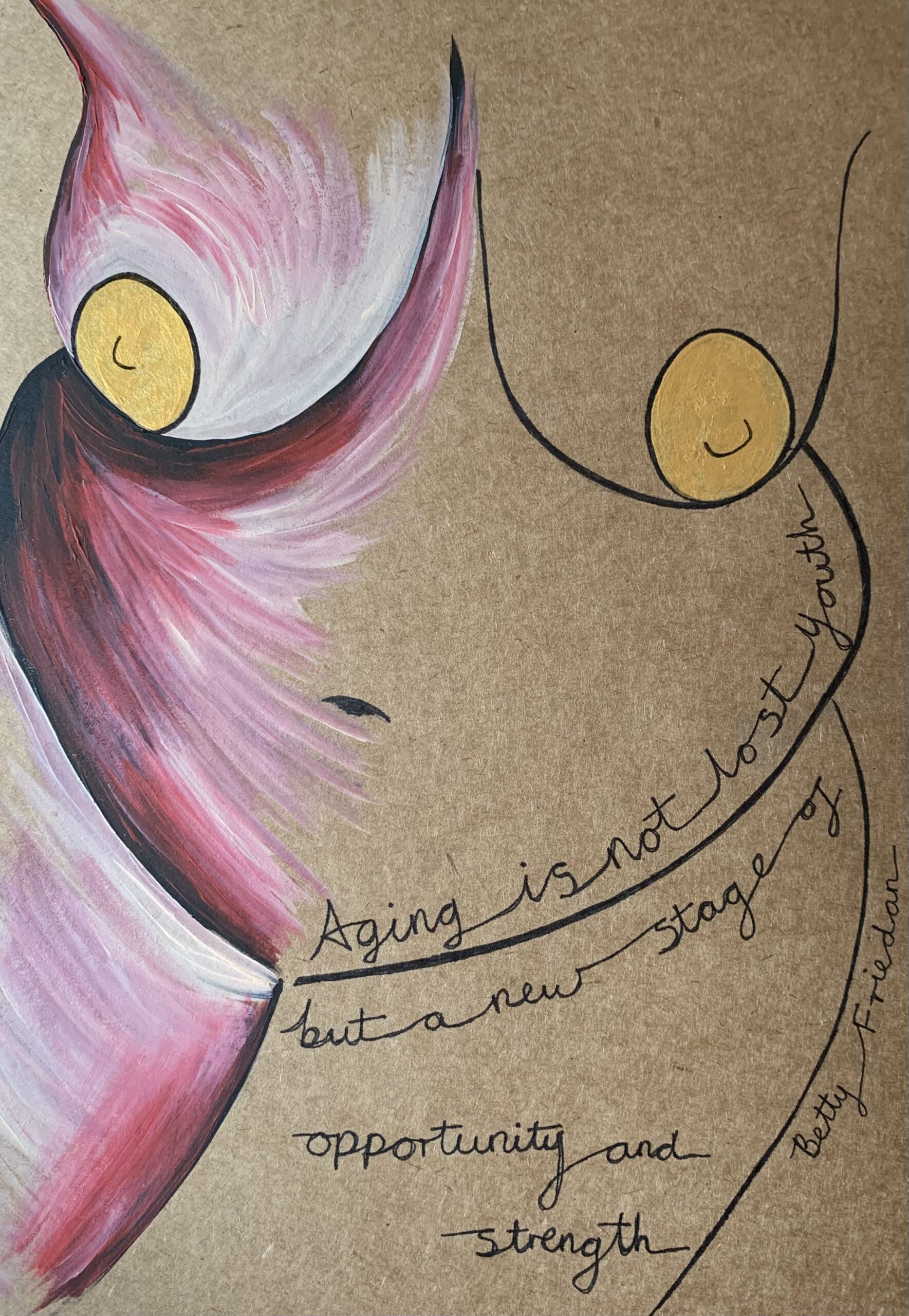
Betty Friedan
Betty Naomi Goldstein, an American writer and activist, was born in 1921 in Illinois to a Hungarian mother (a journalist) and a Russian father.
Friedan gained a psychology degree at a women's college while also pursuing literary activities. However, it was at the University of California that she became involved in several political causes, while on a graduate psychology program. After a year there she moved to New York, where her interest in women's rights grew, and she wrote union pamphlets campaigning for women's workplace rights.
In 1947, she married Carl Friedan, an advertising mogul and would-be theatre producer, and had three children over the next decade, continuing to work. In 1956, the family moved to suburban Rockland County. There, Friedan became predominantly a housewife, but she wrote freelance for women’s magazines and began researching for a book she had in mind (which became The Feminine Mystique).
At a school reunion, her survey of former classmates found that most, like her, were dissatisfied with the limited sphere in which suburban housewives now existed. She spent the next five years interviewing women across the country and concluded that the role of white, middle-class women had changed. Independent and career-minded women, so plentiful in the 1920s and 1930s, were increasingly rare. Post-war housewives were encouraged and expected to find their fulfilment within their homes and families.
Her findings became the basis for many articles, and, eventually, The Feminine Mystique. Published in 1963, it was an immediate bestseller and is now seen as one of the igniting sparks of the second wave of feminism. Women recognised Friedan's "problem that has no name” and spoke up, raising public awareness of women's dissatisfaction with their modern role. It made Friedan a leader of the women's movement. and swelled the movement's numbers.
In 1966, Friedan co-founded the National Organization for Women (NOW) and became its first president. The organisation's mission statement, written by her, was “…to bring women into full participation in the mainstream of American society now, exercising all the privileges and responsibilities thereof in truly equal partnership with men.” NOW's first campaign was for Equal Employment Opportunities.
Friedan's activism burned brightly throughout the 1960s and 1970s. She helped found the National Association for the Repeal of Abortion Laws in 1969 (later known as the National Abortion Rights Action League) and organised the Women’s Strike for Equality in August 1970, on the 50th anniversary of women’s suffrage. Friedan also co-founded the National Women’s Political Caucus in 1971 with Congresswomen Bella Abzug and Shirley Chisholm, and feminist Gloria Steinem.
In later decades, she supported and founded campaigns and organisations against gun violence, pornography, and paying taxes during the Vietnam War. Friedan was instrumental in changing not just people's views, but also outdated laws on hiring practices, gender pay inequality, and pregnancy discrimination. She died in 2006, leaving an amazing legacy.
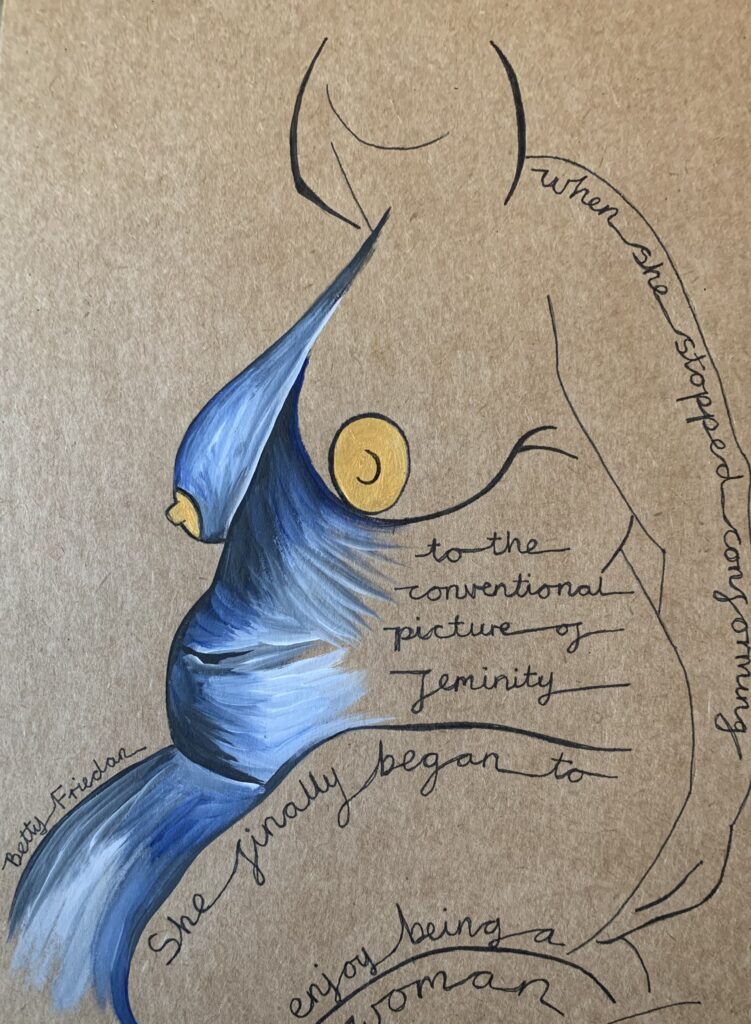
“When she stopped conforming to the conventional picture of femininity she finally began to enjoy being a woman.”
Nawal el Saadawi
Nawal El Saadawi (born 27th October 1931) was an Egyptian feminist writer, activist, physician, and psychiatrist.
El Saadawi was born in Kafr Tahla, a village north of Cairo, and was one of nine children. She underwent female genital mutilation at age 6 despite her parents being relatively liberal for the time and place. Her father was from what she described as "the peasant class," while her mother was from a wealthy upper class, and just 15 when they married. They wanted El Saadawi herself to marry at 10, but she rebelled and her mother supported her.
Initially, she was drawn to music and dancing, but her father could not afford to buy a piano, so she focused on academic study and excelled, meaning she was automatically channelled into medicine. She graduated from the University of Cairo in 1955, specialising in psychiatry, and returned to Kafr Tahla to work as a doctor.
In 1972, she published her first book, Women and Sex, the first of a series of books in which she attacked the aggressions carried out against women and their bodies: female circumcision, the brutal rituals around proving bridal virginity, and more. This controversial book robbed her of her job and forced the closure of her magazine, al-Sihha [Health].
She continued to write, publishing Woman at Point Zero in 1973 and The Hidden Face of Eve in 1977, although she was attracting anger from the state and knew they would eventually move against her - especially as she had been critical of the government.
“They say I am a savage and dangerous woman. I am speaking the truth and the truth is savage and dangerous.”

In September 1981, she was taken from her apartment in Giza during a round-up of 'rebels' that President Sadat had ordered arrested. In prison, imprisoned in a cell with other women, she continued to write her memoir on toilet paper, thanks to an eye pencil she had smuggled in. She also formed the Arab Women's Solidarity Association while imprisoned - the first legal and independent feminist group in Egypt.
A small transistor radio had also been smuggled in, so she and her cellmates quickly heard of the assassination of the president on 6th October. After 4 weeks, she was taken to see the new president, who set her free after talking to her. However, she was furious after being incarcerated for three months, without any contact with her husband and children, having committed no crime - and brought a court case, which she won. Although she carried on writing, it was now under government restriction. Her work was censored, and while she wasn't imprisoned, she was isolated and received death threats. After her inclusion on a 'death list' published in a Saudi newspaper, she and her husband went into exile, and she took teaching posts in European and US universities.
She returned to both Egypt and her campaign against FGM, the veil, and other women's issues in 1996. Around 90% of Egyptian girls were circumcised at the time, and while the practice became illegal in 2008, it made no difference to the statistics.
El Saadawi said: “You can’t change such a deep-rooted habit by passing a law. You need education. The law was passed to satisfy the West. They wanted to cover that disgrace, not to eradicate the practice itself. You have to change the minds of the mothers and fathers and even of the girls themselves, who have been brainwashed to accept it – how long it takes depends on the courage of writers.”
Her Egyptian supporters established the Nawal El Saadawi forum to hold meetings to discuss her books, of which she had written over 50.
"The beginning is always today.”
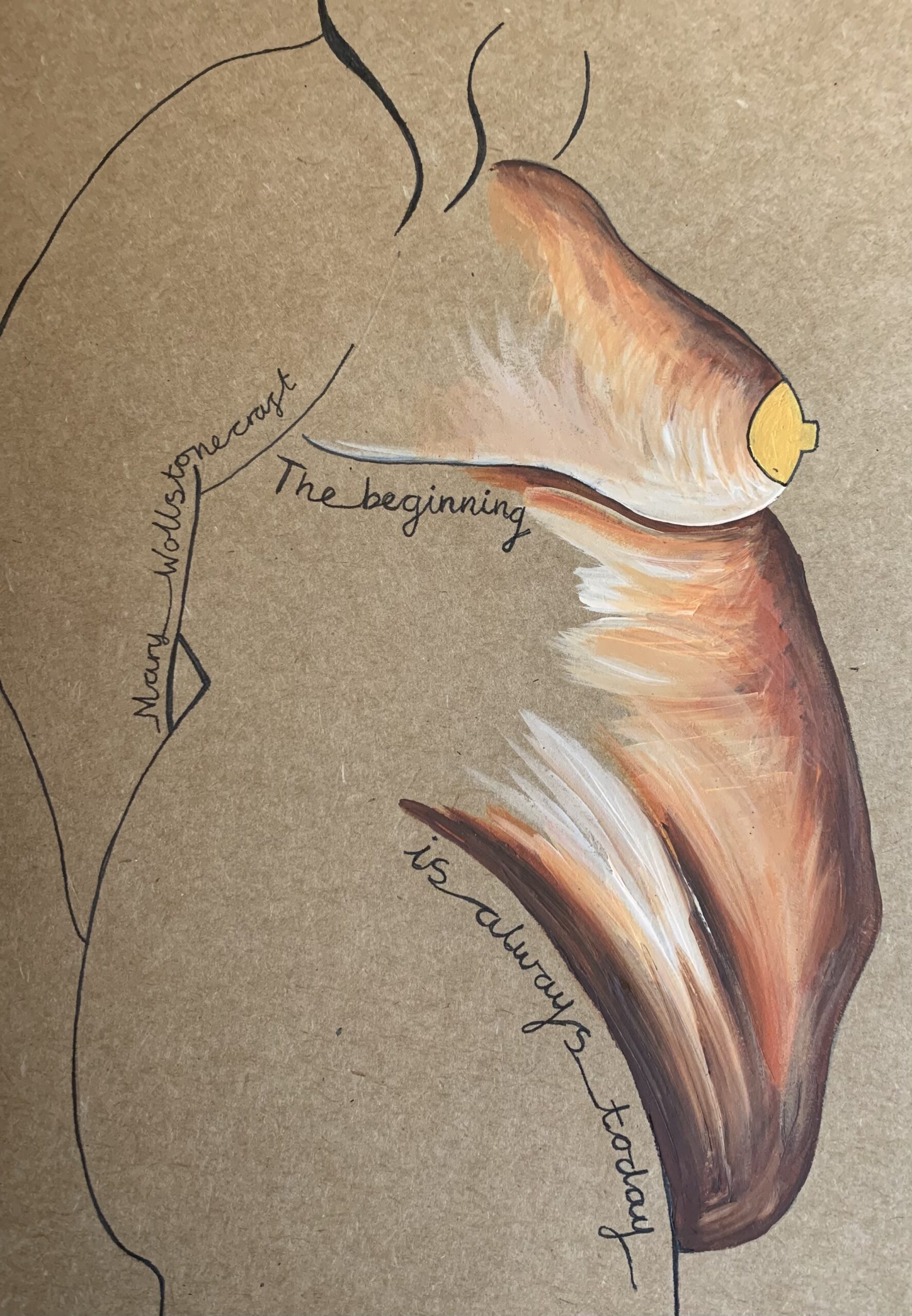
Mary Wollstonecraft
Mary Wollstonecraft (1759 – 1797) was an English writer, philosopher, and advocate of women's rights, and mother of writer Mary Shelley.
Wollstonecraft was born into a wealthy family, but she and her mother were abused by her father - a drunkard who squandered the family's fortune. Her formal education lasted just a few years and she was always resentful of this, particularly because her brother had a much better education. Her feminist ideals were sometimes dangerously ahead of the times, though, and when she persuaded her sister Eliza - who was probably suffering from post-partum depression - to leave her husband and baby, she doomed her to a life of poverty and social condemnation.
Wollstonecraft set about educating herself and earning her own living, and by 25, she had opened a small girls’ school with her sisters and a friend, Fanny. Unfortunately, the school struggled financially and her departure to nurse Fanny, who had married and moved abroad, was its death knell.
After this, she took a job as a governess, albeit unwillingly, with Lord and Lady Kingsborough in Cork. She found her mistress 'frivolous' and deeply unlikeable and longed for the intellectual stimulation of London and her friends. After a troubled and unhappy year, she was fired and returned to London, emotionally and financially drained.
Luckily, the liberal publisher Joseph Johnson hired her as a translator and book reviewer and published her first book, Thoughts on the Education of Daughters, in 1787.
After her rejection by a married suitor, Wollstonecraft went to Paris in 1792 to immerse herself in its revolutionary spirit. Her best-selling book, A Vindication of the Rights of Woman, was published the same year; it passionately advocated for women's access to the same education and opportunities as men, which would enable them to contribute equally to society.
In Paris, she lived with an American captain, Gilbert Imlay, and gave birth to their daughter Fanny in 1994. After their relationship broke down, she returned to London, devastated, and attempted suicide by throwing herself off Putney Bridge.
However, she began to rebuild her life in London, spending time at the house of her publisher, Johnson, and meeting his friends, many of them radical thinkers. His circle included William Blake, Thomas Paine, William Wordsworth, Thomas Holcroft and William Godwin, whom Wollstonecraft had first met at Johnson's house in 1791.
She and Godwin fell in love, and despite Godwin's opposition to marriage on principle, they wed in 1797 when she fell pregnant. However, they continued living separately.
Sadly, when Wollstonecraft gave birth to her daughter, also named Mary, in August, things did not go smoothly. On 30 August, she went into labour and after about 18 hours she gave birth to her second child, a daughter, also named Mary. Although there were only minor complications, the incompetence of the surgeon led to Wollstonecraft suffering haemorrhaging and infection. She died 11 days later, aged just 38.
Although she was a controversial figure, as time went on, Wollstonecraft came to be recognised as a leading light of feminism, lauded by notable figures in the movement such as suffragist leader Millicent Fawcett and writer Virginia Woolf. Today, she is seen as an icon in the ongoing fight against misogyny, inequality and sexual injustice, and her work is still published and read around the world.
“Well behaved woman seldom make history."

Laurel Thatcher Ulrich
This famous quote is variously attributed to Eleanor Roosevelt, Anne Boleyn, Marilyn Monroe and Laurel Thatcher Ulrich. However, the earliest evidence of its use seems to be in an academic paper in American Quarterly in 1976. Later versions sometimes change 'seldom' to 'never' or 'rarely'.
Laurel Thatcher Ulrich is a Pulitzer Prize-winning American historian and writer, and a former professor at Harvard University.
She was born in 1938 in Sugar City, Idaho. She graduated from the University of Utah in 1960 with a BA in English. Over the next ten years, Ulrich raised her family in Boston, where she and her husband had moved for his graduate work at MIT. During this period, she worked with a group of Mormon women to produce a popular guidebook to Boston and found a Mormon feminist newspaper. Exponent II.
She gained an MA in English at Simmons College in 1971 and again moved for her husband’s career, this time, a role at the University of New Hampshire’s Engineering School. As a faculty wife, Ulrich got tuition benefits and decided to study history. After completing a Ph.D. in Early American History in 1980, she accepted a part-time position administering the University’s freshmen humanities program. Her revised dissertation, Good Wives, was published by Alfred A. Knopf in 1982.
Her second book, A Midwife’s Tale: The Life of Martha Ballard, made history - and HERstory. Published in 1990, by which time Ulrich was a full-time member of the UNH history department, the book won the Pulitzer Prize in History—the first book of women’s history to receive the prize.
In 1995, Ulrich accepted a position at Harvard University as James Duncan Phillips Professor of Early American History and Professor of Women’s Studies. There, she continued to write books that shine a light on women, particularly the well-behaved ones whom history often ignores, and the unrecorded inheritance of women – the skills, household and work items they pass down in families. In 2001, she published The Age of Homespun: Objects and Stories in the Creation of an American Myth, examining early American history through domestic objects including fabric, baskets, tools and furniture – objects handed down from mother to daughter with no legal record.
She says: “If you can investigate history, and begin to rewrite history, then you have a different orientation toward the future. History is our job. If we just sit and passively accept our own circumstances, nothing will change. So: well-behaved women seldom make history.”
in 2004, Ulrich published Yards & Gates: Gender in Harvard and Radcliffe History – the result of her cooperation with students, colleagues, and alumnae, and in 2006, she became 300th Anniversary University Professor. The title was partly in recognition of her ability to engage in interdisciplinary scholarship and teaching, especially in Harvard’s many museums.
In 2007, she published Well-behaved Women Seldom Make History and in 2015 Tangible Things: Writing History Through Objects, co-written with Ivan Gaskell, Sara Schechner, and Sarah Anne Carter.
Ulrich’s 2017 book, A House Full of Females: Plural Marriage and Women’s Rights in Early Mormonism, 1835-1870, was written using some of the same research strategies she had developed previously. She used artefacts such as diaries, ledgers, meeting notes, and quilts to study female activism, including women’s securing of the vote in Utah decades before the 19th Amendment was passed.
Ulrich continues to be fascinated by the intersection of race, religion, and women’s rights in the United States from the Revolution onwards, but she has now retired from Harvard, leaving her position in 2018.
"The truth will set you free, but first it will piss you off."
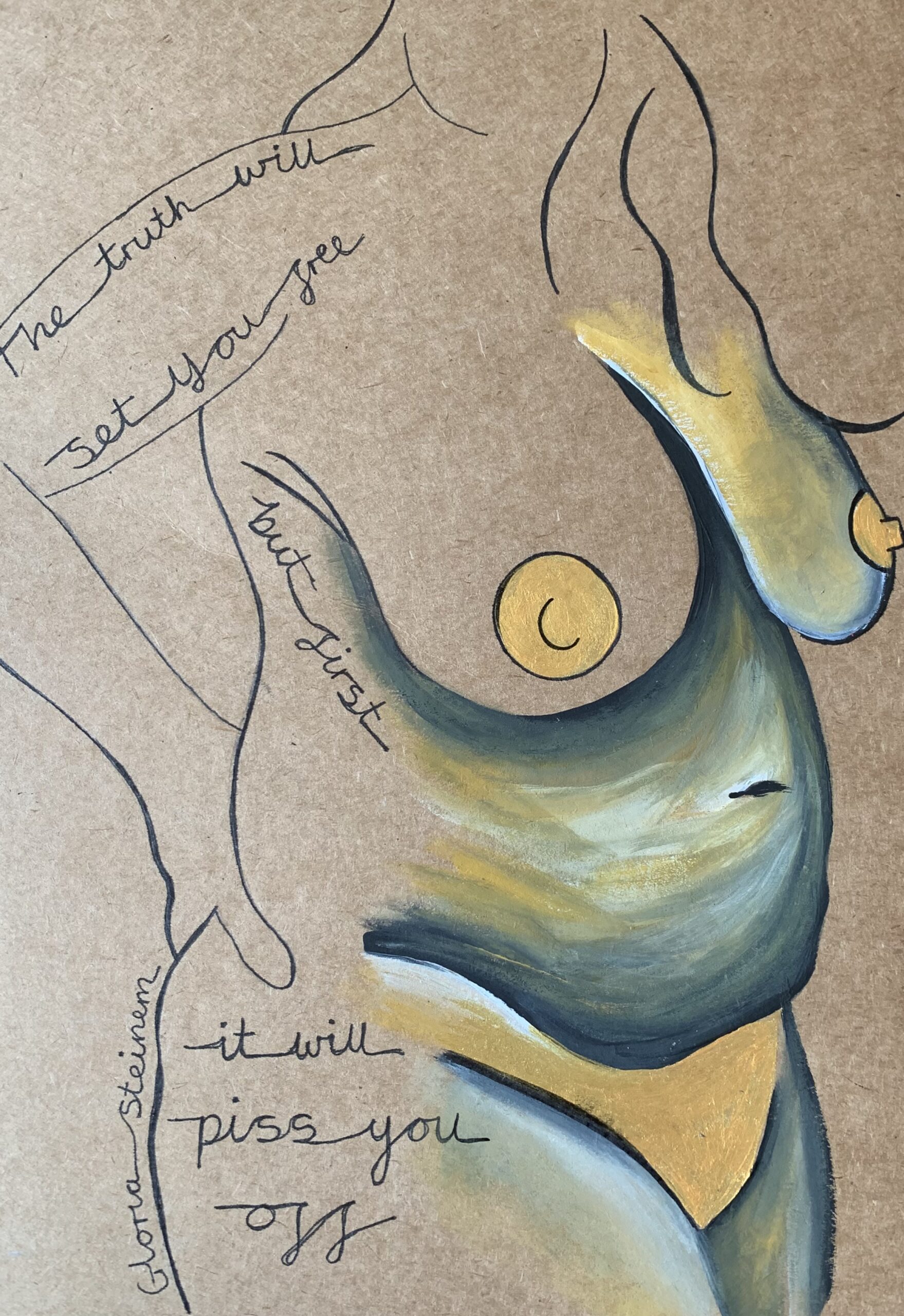
Gloria Steinem
Gloria Steinem is an acclaimed American journalist, a political activist, a passionate leader spokesperson for the women’s rights and a famous proponent of feminism.
Steinem was born in Toledo, Ohio in 1934 and her early life was spent travelling with her parents. After their divorce, her mother settled back in Toledo and Steinem started attending school regularly. However, she also had to take care of her mother, who suffered from severe mental health issues that saw her hospitalised for long periods.
Steinem studied government at Smith College in Massachusetts where she graduated magna cum laude in 1956 and earned the Chester Bowles Fellowship. This scholarship enabled her to spend two years studying and researching in India. There, she took part in protests against government policies and was inspired by this taste of grassroots activism.
“Don’t think about making women fit the world – think about making the world fit women.”
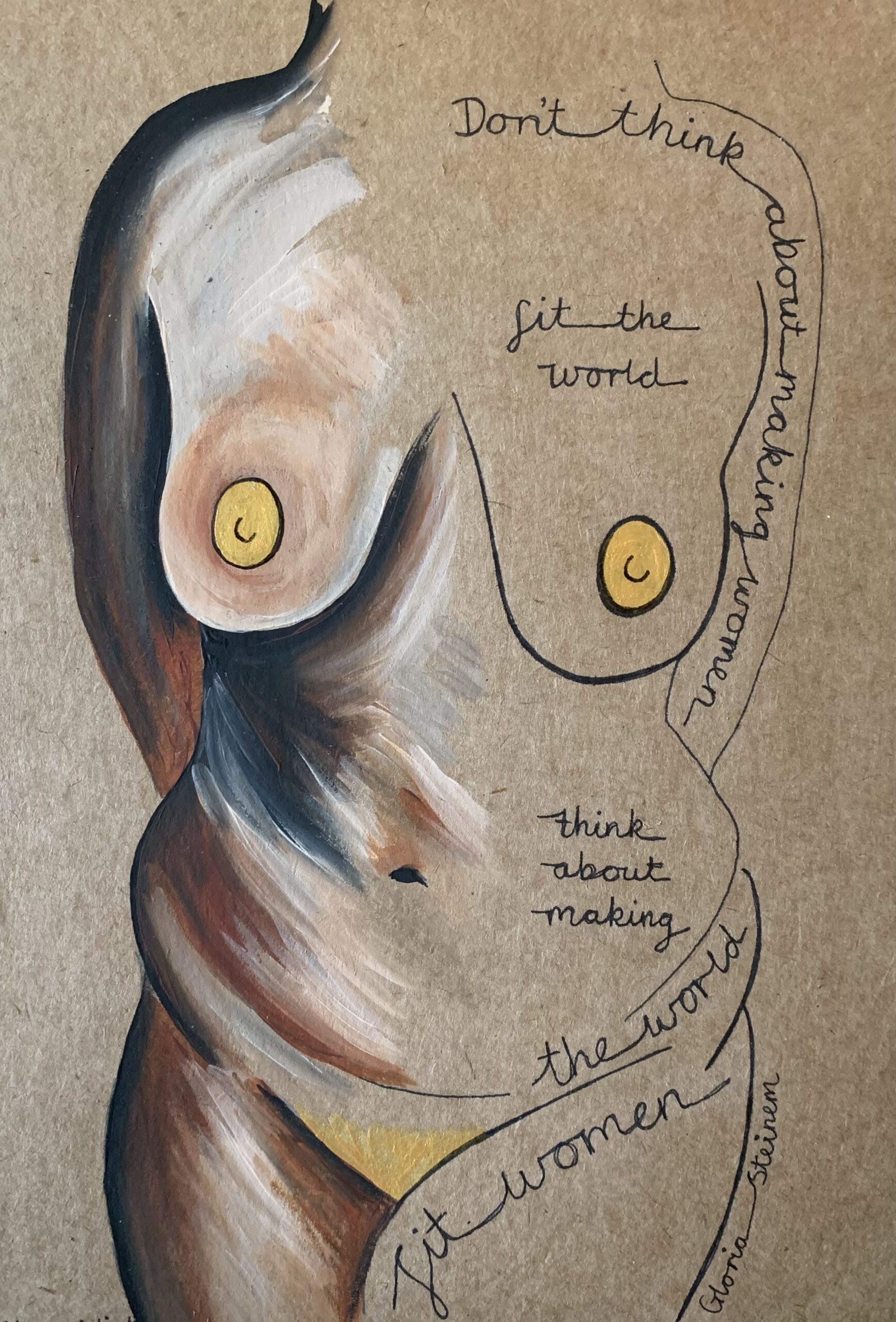
In 1960 she began working in the male-dominated world of freelance wring and journalism in New York City. She found it hard to break away from writing ‘women’s pages’, despite offering ideas for political stories. In 1963, Show magazine hired her to go undercover to report on working conditions at Hugh Hefner’s Playboy Club. Her resulting article, I Was a Playboy Bunny, attracted attention – but not the kind she wanted, merely increasing her struggle to be taken seriously as a journalist.
Her solution was to help found a magazine. In 1968, New York magazine launched with Steinem on board as an editor and political writer. In her column, The City Politic, she covered political campaigns and progressive social issues such as the women’s liberation movement. She also began to speak publicly about causes close to her heart, including making a speech at an event campaigning for the legalisation of abortion in 1969 – where she shared her own story of having an abortion. This inspired her to speak at more events and protests, where her intelligence soon made her a popular speaker.
In 1971, Steinem founded the National Women’s Political Caucus with Betty Friedan, Bella Abzug, and Shirley Chisholm, to support gender equality and pro-equality candidates in public office. She also founded a new women’s magazine with journalists Patricia Carbine and Letty Cottin, that would discuss contemporary issues from a feminist viewpoint. By December, the first issue of Ms. magazine was out, included as an insert in that month’s issue of New York. It became a standalone publication in the following year. Steinem remained an editor and writer for the magazine for the next fifteen years and has continued to be involved in its leadership.
Steinem co-founded many groups and movements including the Women’s Action Alliance (1971), which promotes non-sexist, multi-racial children’s education; the Coalition of Labor Union Women; Voters for Choice (1977), a pro-choice political action committee; Women Against Pornography; and the Ms. Foundation for Women. In the 1990s, she also helped establish Take Our Daughters to Work Day, hoping to empower young girls to learn about potential careers, and in 2004, she founded the Women’s Media Center to promote positive images of women in media.
In 2000, at age 66, Steinem married for the first time. Sadly, her husband, entrepreneur and activist David Bale, died just four years later.
Steinem's award-winning writing has continued alongside her activism throughout her life. Her work is featured in numerous anthologies and textbooks, and she has authored several books including Marilyn, a biography of Monroe, and her best-selling memoir, My Life on the Road. She also hosted a TV documentary series on female issues in 2016, entitled Woman with Gloria Steinem.
In 2013, President Barack Obama presented her with the Presidential Medal of Freedom, and Rutgers University created The Gloria Steinem Endowed Chair in Media, Culture, and Feminist Studies in her honour in 2017.
"No need to hurry, no need to sparkle. No need to be anything but oneself.”

Virginia Woolf
Adeline Virginia Woolf was a free spirit and a renowned author: a pacifist, a pioneer of early twentieth-century feminism, and the friend and lover of other free spirits of the time such as Vita Sackville-West.
Woolf was born in 1882 to Sir Leslie Stephen, a writer, historian and mountaineer, and his second wife, noted philanthropist Julia Duckworth.
Growing up in Kensington with her siblings and stepsiblings, Woolf was well-educated, but mainly through her own efforts. She supplemented her fragmentary home education with time spent amongst her father’s many books and educated, radical friends, and attended lectures at the Ladies' Department of King's College London from 1897 to 1901. There, she met people connected to early women's rights and educational reform movements.
"For most of history, anonymous was a woman.”

Her mother died when she was just 13, which precipitated a nervous breakdown, and after her father died in 1904 she suffered poor mental health again. After his death, the family moved to Bloomsbury, a more bohemian area. There, they formed the artistic and literary Bloomsbury Group with literary and artistic friends including Clive Bell, E.M. Forster and Leonard Woolf. Woolf began to earn some money from writing reviews and started the ‘Friday Club’: dedicated to the discussion of the fine arts, it included her sister Vanessa’s friends and fellow artists. She travelled widely with family and friends during this period, but back in London in 1912, she married Leonard Woolf. Her first novel, The Way Out, was accepted for publication, but she found the editing process stressful. Her mental health suffered badly, and she attempted suicide in 2013; this delayed the publication of her novel until 1915.
In 1917, she and Leonard founded the Hogarth Press, publishing Woolf’s short story Key Garden the year after. She went on to write novels that are now classics, such as Mrs Dalloway (1925), To the Lighthouse (1927) and Orlando (1928), and landmark essays such as A Room of One's Own (1929). She had almost completed her novel Between the Acts when her mental health declined, and she fell into a deep depression. On 28th March 1941, Woolf drowned herself by walking into the nearby River Ouse.
Woolf’s writing is known for shining a light on women’s rights to a good education, fair pay and financial freedom - without which, she argued, they could have no creative or intellectual freedom either. Her work has been translated into over 50 languages, widely adapted for stage and screen, and analysed and studied by generations of literary and feminist scholars.
“Free-thinking, powerful, passionate women are dangerous to a conservative male-dominated culture.”
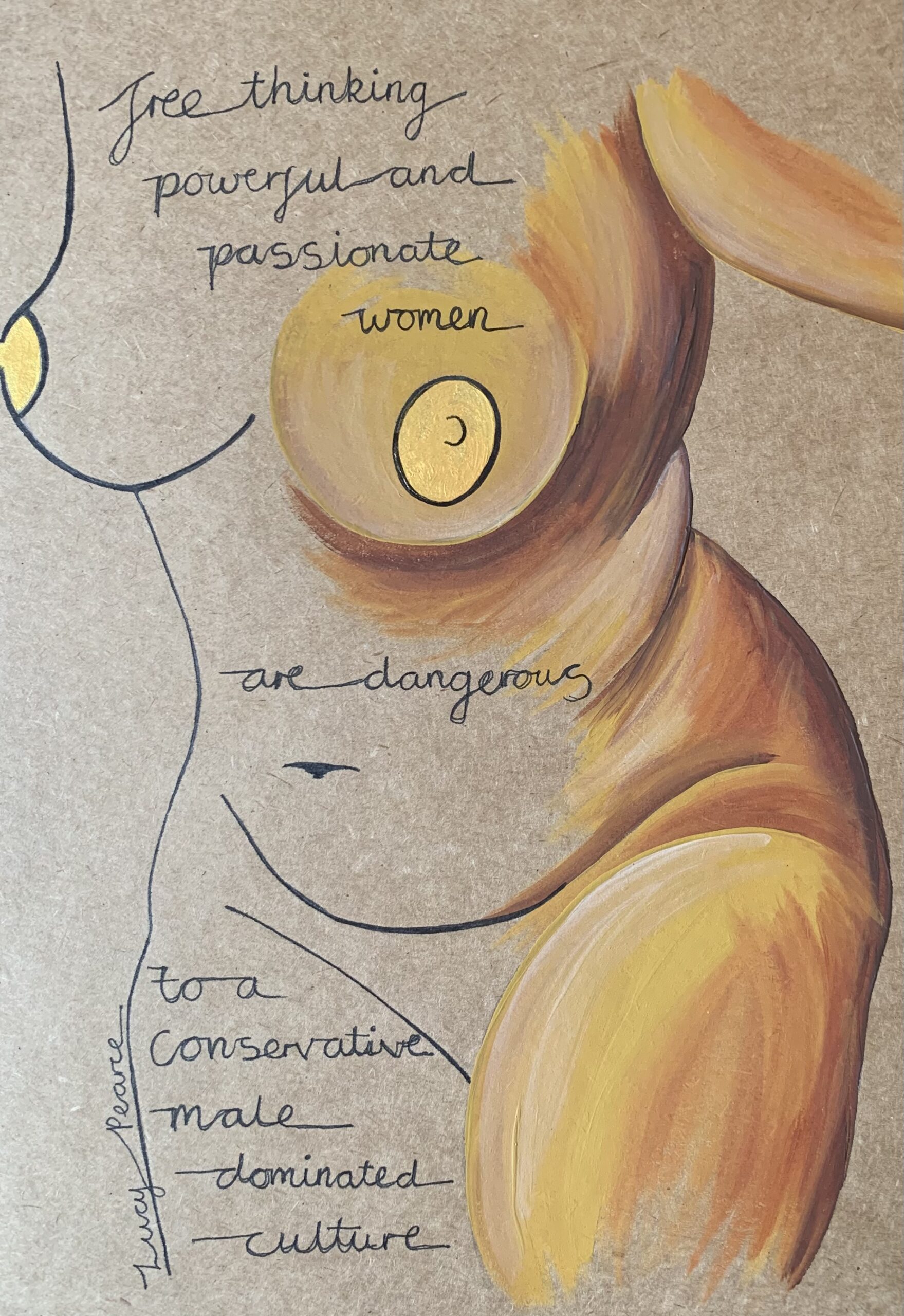
Lucy Pearce
“Free-thinking, powerful, passionate women are dangerous to a conservative male-dominated culture. They tend to do what they want and believe it is right… not what you tell them.”
Pearce is a writer, editor, artist and women's workshop facilitator living on the coast of Ireland. An award-winning graduate in History of Ideas with English Literature from Kingston University, she holds a PGCE from Cambridge University and was The Writer’s Bureau runner-up Writer of the Year.
Pearce was the contributing editor and columnist at JUNO magazine for six years, and her articles have appeared in newspapers, websites and magazines around the world. In 2014, she founded Womancraft Publishing. It publishes books that aim to “challenge, inspire, heal and speak to the silenced aspects of ourselves.” from diverse international women authors and artists.
Pearce herself is a Three-time Nautilus award-winning author. Her non-fiction titles for women include her best-selling Burning Women, “an incendiary exploration of women and power,” which explores women who burn with passion or shame, and those who would have been burned at the stake in less enlightened times.
Her writing focuses on women’s healing through archetypal psychology, embodiment, historical awareness and creativity.
Chalotte Bronte
Charlotte Brontë was one of the best-known writers and poets of the Victorian era, and her novels are still widely read and adapted today.
Charlotte was born in 1816 in Yorkshire, to Patrick, a parson, and Maria, who died when Charlotte was just 5. Charlotte’s aunt moved in to care for the family, but Charlotte and her five siblings were often left to entertain themselves, reading for hours and roaming the moors. In 1824, Charlotte and her younger sister Emily joined their older sisters, Maria ad Elizabeth, at the new Clergy Daughters’ School. Maria and Elizabeth became ill living in the school's unsanitary conditions, and died in 1825, After this, Patrick Brontë home-schooled his four remaining children. They all had literary inclination and talent, producing a family magazine and numerous stories and poems about their intricate, imaginary world, Glass Town.
Charlotte spent 1831-32 at Roe Head boarding school. She returned there to teach from 1835 to 1838 but was very unhappy. This may have spurred her, in 1836, to decide she wanted a career as a poet. However, when she sent her poems to Robert Southey, England's poet laureate, he sent a misogynistic response that's now infamous: “Literature cannot be the business of a woman’s life: & it ought not to be. The more she is engaged in her proper duties, the less leisure she will have for it, even as an accomplishment & a recreation.”
Undeterred, Charlotte continued writing poetry while working in a series of governess posts she hated, and while learning and teaching with Emily at a Brussels boarding school).
"I would always rather be happy than dignified."

n 1846, she, Emily and Anne published a self-financed volume of their poems. To protect against sexist bias, they used the pseudonyms Currer, Ellis and Acton Bell. However, it was her first published novel, Jane Eyre, that brought her fame. Also published under 'Currer Bell', it drew on her unhappy times at her first school and as a governess., Its success gained her acceptance in London literary circles, where she befriended writers Elizabeth Gaskell and Harriet Martineau.
She began work on Shirley in 1948 but due to the loss of her brother Branwell, and then her sisters Emily and Anne, it was not published until October 1949. It reflected her support for women’s rights and workers’ rights. Brontë's third novel, Villette, was published in 1853, and was accused, like her earlier works, of being ‘unfeminine’ and ‘coarse’.
In 1854, she married her father’s curate Arthur Nicholls, and soon became pregnant. Sadly, she became unwell, suffering severe morning sickness, and died aged 38 on 31st March 1855. The Professor, a novel completed before Jane Eyre but initially rejected, was published posthumously in 1857.
“I don’t want to get to the end of my life and realise I lived just the length of it. I want to have lived the width of it as well.”

Diane Ackerman
Diane Ackerman (born 7th October 1948) is a poet, essayist, and naturalist.
Born in Illinois, Ackerman gained a BA from Pennsylvania State University and an M.F.A., M.A., and Ph.D. from Cornell University. She went on to teach English at the University of Pittsburgh and from 1984 to 1986, she was director of the writers’ program and writer in residence at Washington University in Missouri. She later became a staff writer at The New Yorker magazine (1988–94).
Ackerman's work is known for intertwining her two loves: poetry and nature. She has travelled extensively, researching the lives of the creatures that fascinate her: endangered golden lion tamarins in Brazil, right whales in Patagonia, short-tailed albatrosses in Japan, penguins in Antarctica, and many more.
“Touch is as essential as sunlight.”
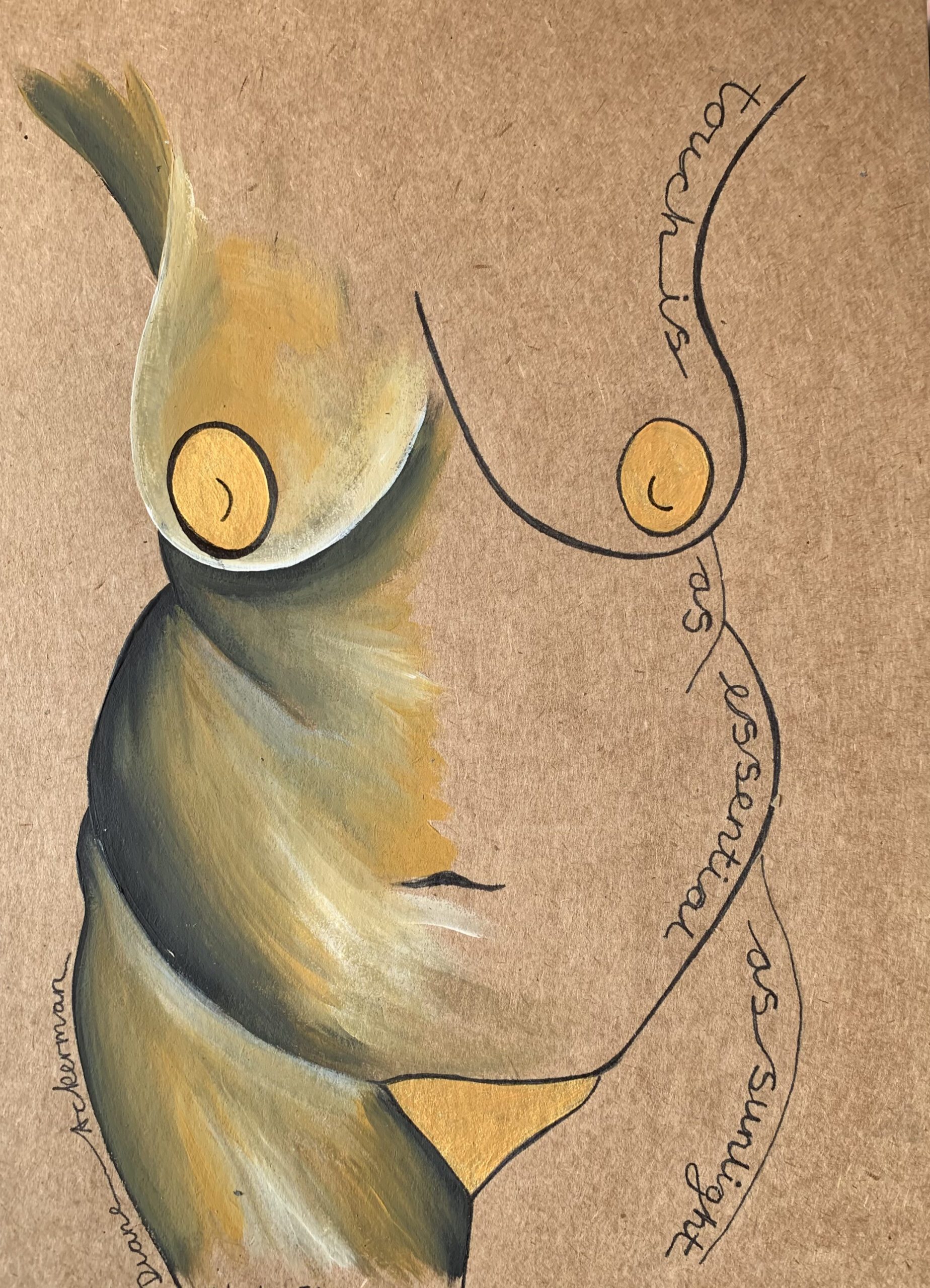
Her success comes from so convincingly transferring her love for the natural world and her endless curiosity onto the page, in essays, articles and poetry. Her work has appeared in The New York Times, Smithsonian, Parade, The New Yorker, National Geographic, and many other publications. She is also the author of nonfiction books, children's books, and volumes of poetry.
In 2012, Ackerman was a finalist for both a Pulitzer Prize and a National Book Critics Circle Award for One Hundred Names for Love. In 2015, her The Human Age won the National Outdoor Book Award (Natural History Literature) and PEN New England's Henry David Thoreau Prize (nature writing).
She has also written a memoir, On Extended Wings, and a book about her time as a counsellor in a crisis centre (A Slender Thread: Rediscovering Hope at the Heart of Crisis). Ackerman's 2007 book, The Zookeeper’s Wife, tells the true story of zoo proprietors and their concealment of hundreds of Jews in Nazi-occupied Warsaw and was adapted for film in 2017.
Ackerman has received many honours for her work. She was a semi-finalist for NASA's Journalist-in-Space Project in 1986 and is a Fellow of the New York Institute for the Humanities. Perhaps one of her most unusual accolades has been to have a crocodilian sex pheromone named after her. The molecule is now known as dianeackerone.
“In her life she is the proof of woman’s capacity and will to survive”
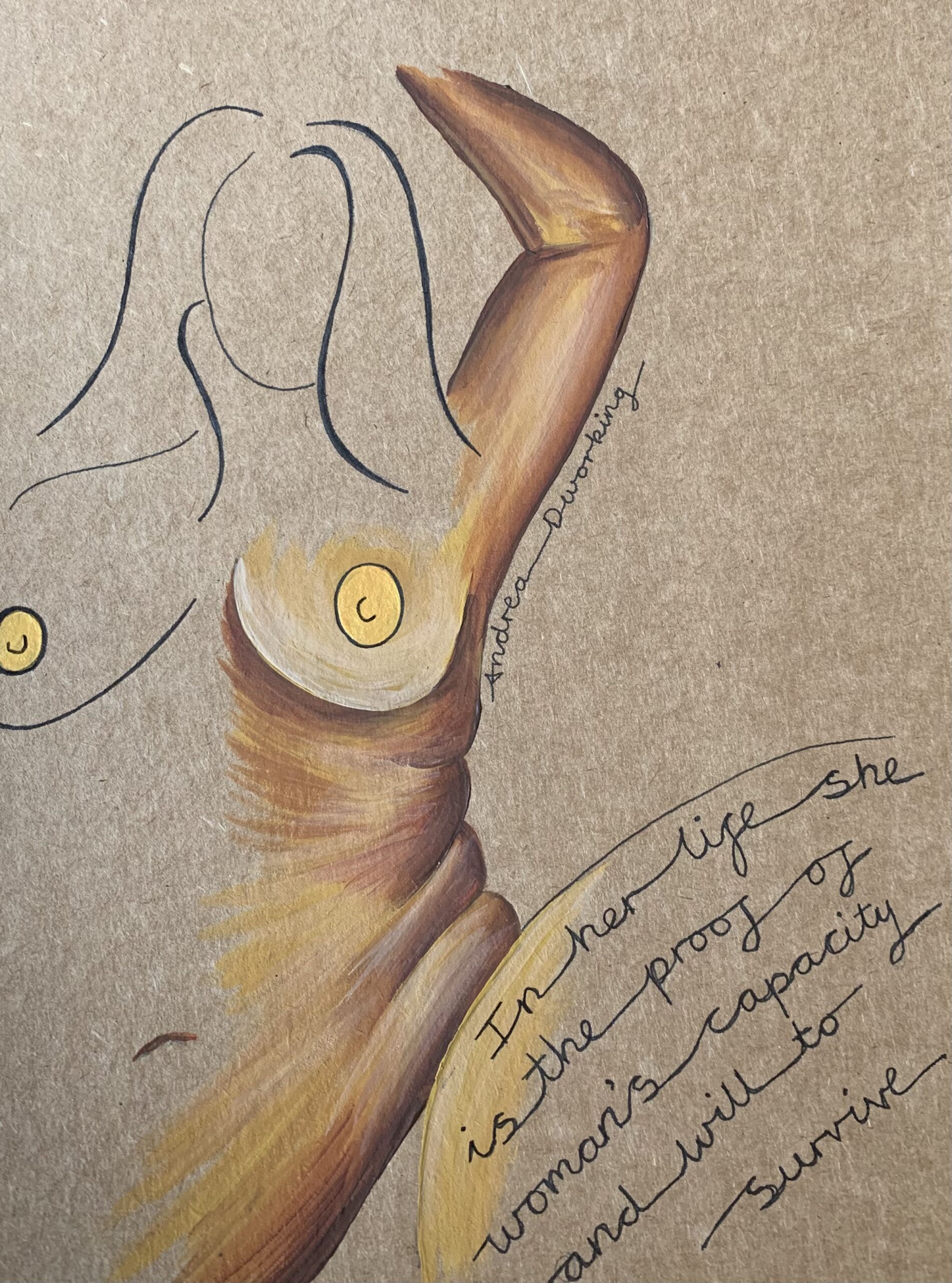
Andrea Dworkin
Dworkin was born in New Jersey in 1946, to a socialist father and a mother who, while wanting Dworkin to marry a ‘nice’ man, nevertheless held views about the availability of birth control and abortions that were ahead of the time. Their views influenced Dworkin’s thinking.
While studying for her BA at Bennington College in Vermont, she was arrested while protesting against the Vietnam War, and incarcerated at the Women’s House of Detention in New York. Her experiences there, including a brutal internal examination, led to her going before a grand jury to testify about her treatment, which made international headlines and caused the closure of the detention centre.
After graduation from Bennington in 1968, and a period spent in Crete writing, Dworkin went to Amsterdam to write about a Dutch anarchist group. She married one of them, but he quickly became physically and emotionally abusive, and stalked her when she escaped. Dworkin turned to sex work to make money, but only gathered the funds to return to the US by agreeing to be a drug mule. She also carried the manuscript of her book, Woman Hating: A Radical Look at Sexuality, which was published in 1974. It highlighted misogyny in society and story.
Dworkin went on to write many books and essays about feminist issues and sexual politics, as well as fiction and poetry. She was also an avid campaigner against pornography and the poor treatment of women in the sex trade.
One of her most famous works was Pornography and Civil Rights: A New Day for Women’s Equality (1988), written with Yale Professor of Law Catharine A. MacKinnon. The pair also tried to get legal ordinances passed to enable women poorly treated in the porn film industry to sue filmmakers.
A controversial figure and self-professed lesbian, she was often accused of hating sex and men. She spent time as a university lecturer and often spoke publicly about her views on male domination. In a famous speech to an anti-sexist men’s organisation in 1983, she said: “The power exercised by men, day to day, in life, is power that is institutionalised. It is protected by law. It is protected by religion and religious practice. It is protected by universities, which are strongholds of male supremacy. It is protected by a police force. Against that power, we have silence.”
After becoming the victim of drug rape in 1999, she withdrew from public life. She carried on writing, however, producing the award-winning Scapegoat: The Jews, Israel and Women's Liberation in 2001. In 2002, her memoir, Heartbreak: The Political Memoir of a Militant Feminist was published, and gave her a new enthusiasm for activism and public life before she died in 2005.
Dion Fortune
Dion Fortune was born Violet Mary Firth in Llandudno, North Wales in 1890. Her parents ran a spa and her mother later became a Christian Science healer, introducing Fortune to alternative health and wellness practices.
Fortune spent time at a horticultural college before studying psychology at the University of London. While working as a counsellor in psychotherapy in 1916, she developed an interest in occultism, believing it might hold answers that psychology did not. She beame a member of a lodge run by Theodore Moriarty, then joined the Golden Dawn and the Theosophical Society. However, not truly happy with any of these organisations or with running a group under their wing, she eventually founded The Society of the Inner Light, an independent group. It was initially headquartered at Glastonbury Tor, where a few years before, in 1922, she had met Charles Loveday. A fellow student of occultism, he would become a lifelong friend. While at the Chalice Well at the foot of the Tor, they claimed they had received the first teachings from an inner plane group, the Company of Avalon. The Society later bought a house in London too, and this larger building became the headquarters. Fortune continued to contact Masters (inner plane adepts) through trance mediumship.
Fortune went on to write many books, both fiction and non-fiction, and also articles for her house journal, Inner Light Magazine. These texts became the core of the society’s doctrines. During World War II, she organised an extended meditation group to protect Britain, operating even as a bomb brought down the roof of her HQ in 1940.
Fortune died of leukaemia in 1946 and was buried in Glastonbury cemetery. The Society outlived her, although today it is an initiatory school run on the same principles. It has spawned many other groups in the Western esoteric tradition.
"A religion without a Goddess is halfway to atheism.”

Angela Anaïs Juana Antolina Rosa Edelmira Nin y Culmell (1903 – 1977), known professionally as Anaïs Nin, was a French-Cuban American writer best known for her memoirs, whose frank depictions of sex from a woman’s point of view caused controversy.
Nin was born in France to Cuban parents, who separated when Nin was two. Nin moved with her brothers and mother to Barcelona, and then, in 1914, to New York. After dropping out of school at 16, she worked as an artist’s model. Nin married her first husband Hugh Parker Guiler in 1923 and they moved to Paris, where she began writing. D. H. Lawrence: An Unprofessional Study, was her first published work, printed in 1932, and through this, she met writer Henry Miller, a lifelong friend and sometimes lover.
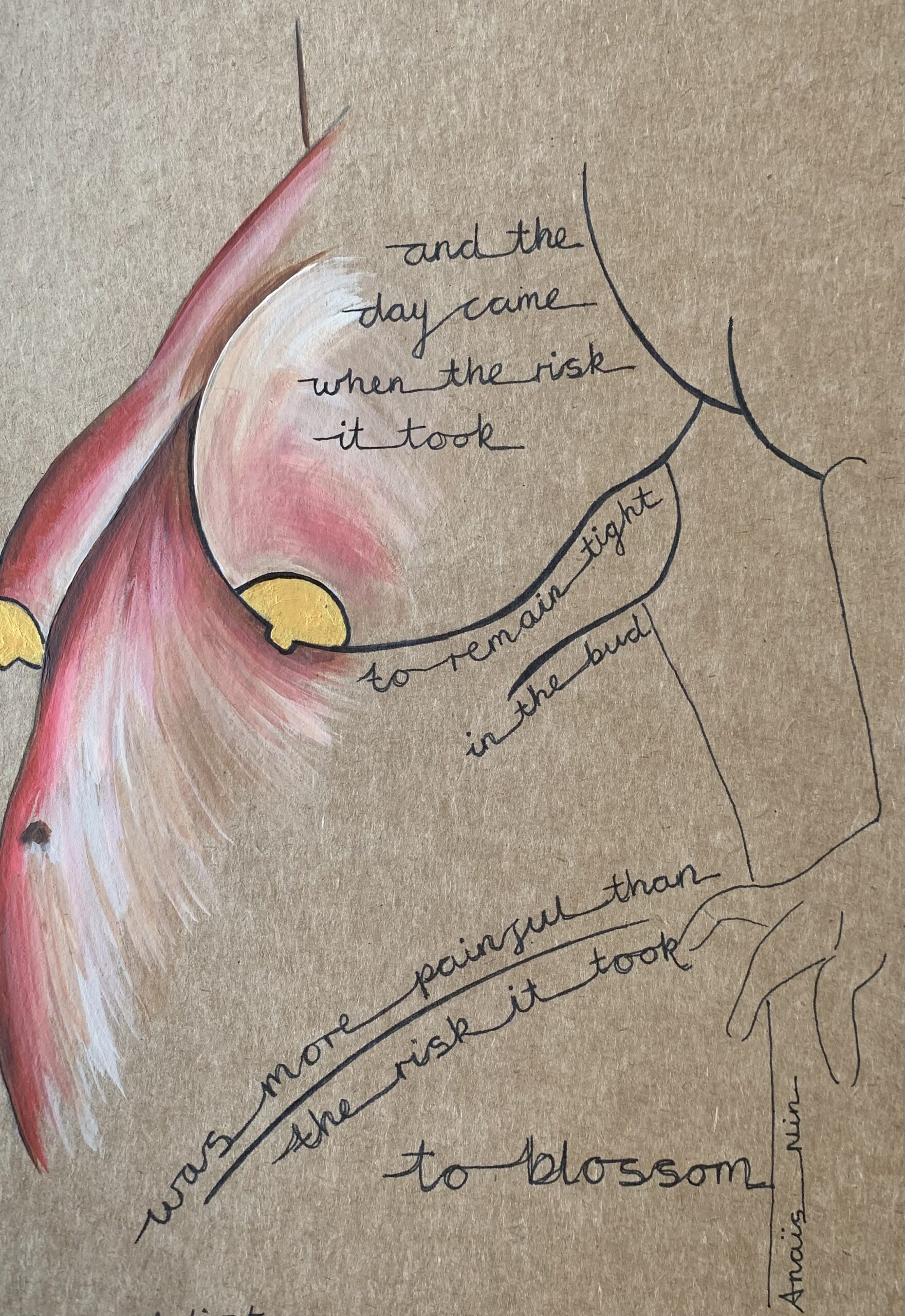
“And the day came when the risk it took to remain tight in the bud was more painful than the risk it took to blossom.”
Anais Nin
"Life shrinks or expands in proportion to one's courage.”
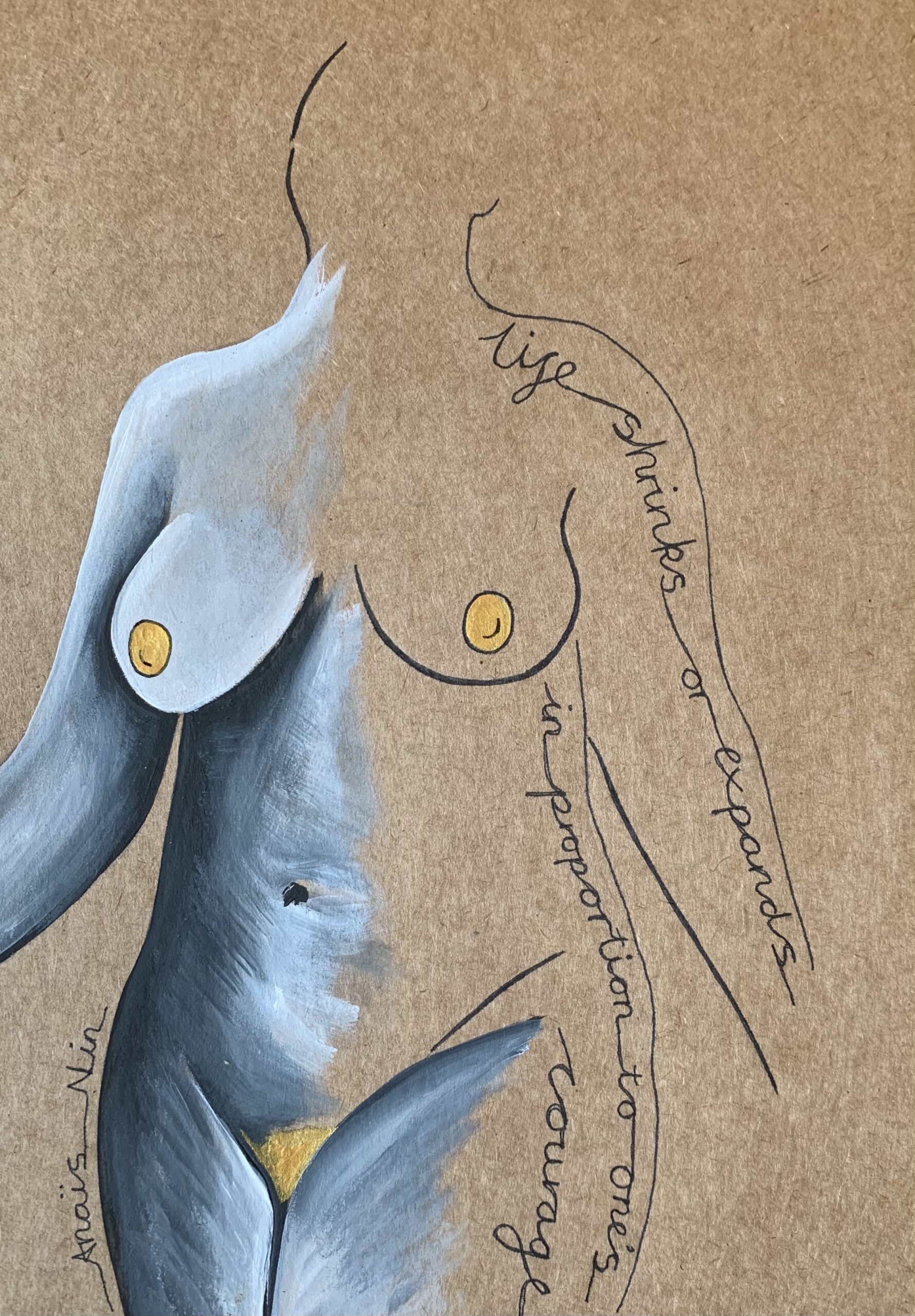
Covering 50 years of her life, it received rave reviews and critical recognition. However, it was very controversial too: her frank portrayals of illegal abortions, extramarital affairs and incest, were too much for many people. Nin wrote about these topics from a woman’s point of view, without judging her female characters. That’s brave in 2015; in 1940, it was career suicide, and she was accused of sexual perversion.
She was also accused of narcissism and sociopathy, believing as she did that her Diary was a great work of literature featuring her most captivating character - herself. However, ultimately Nin came to be seen as a feminist icon, greatly admired by many for writing and living as she wanted to in a male-dominated world. She died in LA in 1977.
She also became fascinated by psychoanalysis, studying first with René Allendy and then with Otto Rank, both of whom she had romantic relationships with. To make money, she began writing erotica at this time, paid by an anonymous collector; they weren’t published until after her death.
When World War II began, she returned to New York and self-published stories and novels, including Ladders to Fire (1946), Children of the Albatross (1947), The Four-Chambered Heart (1950), A Spy in the House of Love (1954), and Solar Barque (1958).
These works only gained widespread attention in 1966, when the seven-volume work, The Diary of Anaïs Nin, was published.
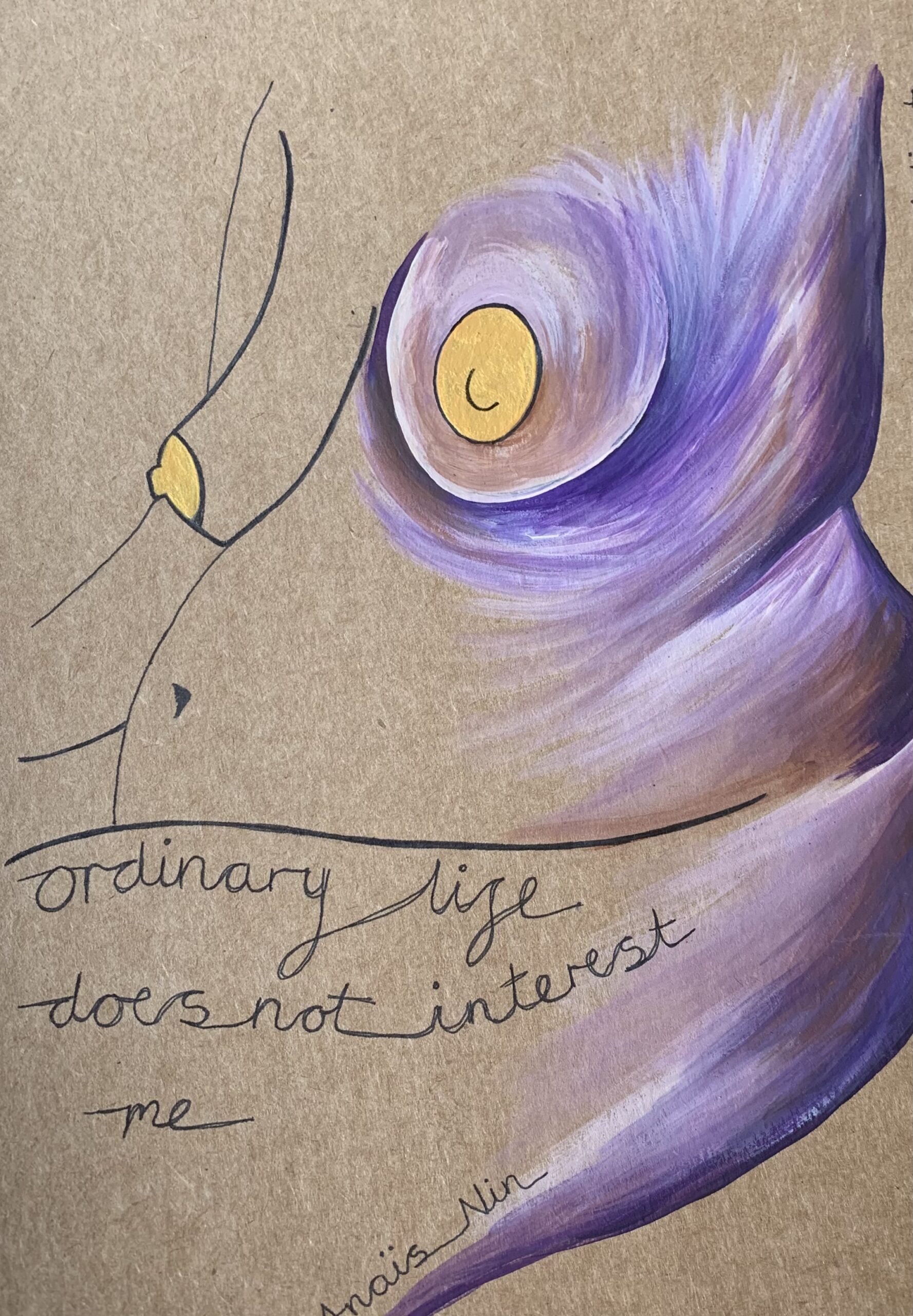
"Ordinary life does not interest me."
“Live life fully, live life passionately.”
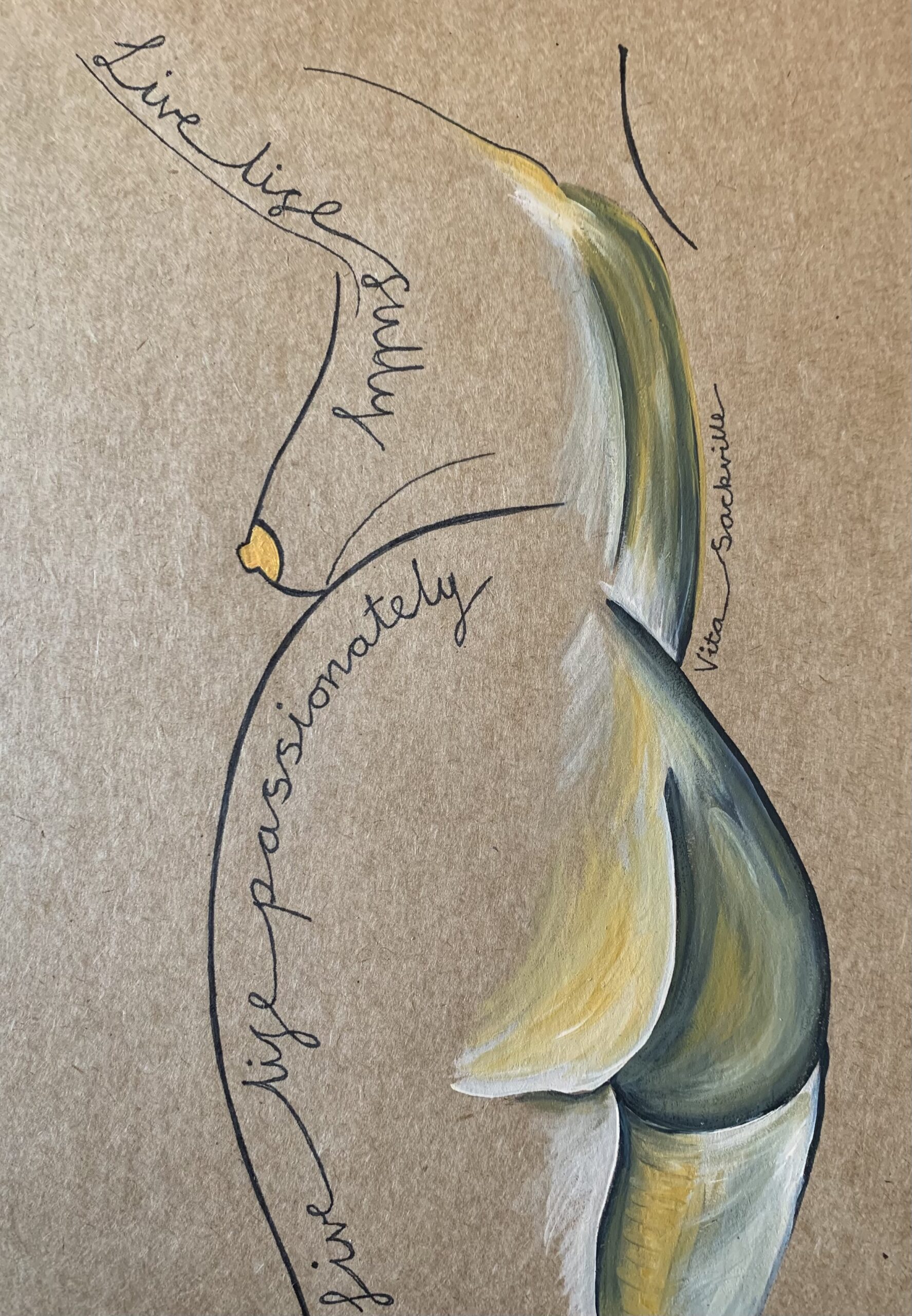
Vita Sackville-West
“Be wicked, be brave, be drunk, be reckless, be dissolute, be despotic, be an anarchist… be anything you like, but for pity’s sake be it to the top of your bent. Live – live fully, live passionately, live disastrously.”
Victoria Mary Sackville-West was born in 1892 at Knole Estate, the only daughter of Lionel Edward Sackville-West (later third Baron Sackville) and his cousin Victoria. She loved the estate and would volunteer to take visitors on tours, but always resented the fact that as a woman, she could not inherit it. Instead, it passed to her cousin Eddy after her father's death. Aside from exploring the estate, she also spent hours writing; by eighteen, she had written eight novels, five plays, and poetry.
In 1913, she married Harold Nicolson, a diplomat who would later be involved in writing the Treaty of Versailles. Like Vita, he was bisexual, but while they both indulged in extra-marital same-sex liaisons (most famously, Vita's with Virginia Woolf, a fellow member of the Bloomsbury Group), they maintained a mostly happy marriage. Their time spent in Constantinople inspired her to write Poems of East and West in 1917, and this work marked the start of a long professional writing career. In 1927, she won the Hawthornden Prize for her poem The Land (1926), but she was already pursuing a parallel passion: garden design.
The Nicholsons purchased Sissinghurst Castle in Kent in 1930 and spent many years renovating the neglected Elizabethan mansion and its garden. There, Vita continued to write poetry and fiction, including her best-known novels, The Edwardians (1930) and All Passion Spent (1931), never afraid to challenge the societal rules and morality of the time. She also wrote biographies, and books and columns on gardening.
In 1928, she began speaking for the National Trust; she and Harold became Trust council members and she assisted in the negotiations for the NT's takeover of the Knole estate in the early 1940s.
In 1947, Vita was made a Fellow of the Royal Society of Literature and Companion of Honour. Her body of work includes twelve poetry collections, seventeen novels, and nine non-fiction works. Sissinghurst became a Trust property upon her death in 1962, and visitors continue to be fascinated by the tower where she wrote many of her works and the beautiful gardens she created with Harold.
Louise L Hay
Louise Lynn Hay) was an American motivational author of several New Thought self-help books, including You Can Heal Your Life - and I can say with my hand on my heart that this book truly changed my life.
Louise Hay was born in California in 1926. Brought up in an impoverished and unstable home by her mother and her violent stepfather, she was raped by a neighbour at just 5 years old. She suffered further abuse in her teenage years. At fifteen she dropped out of high school and became pregnant, giving her daughter up for adoption when she was 16.
After working in menial jobs in Chicago, Lousie moved to New York in 1950. Here, she changed her name and began a successful fashion modelling career. In 1954, she married wealthy businessman Andrew Hay, but he left her fourteen years later for another woman.
Devastated, Hay nonetheless rebuilt her life and began attending the First Church of Religious Science on 48th Street in 1970. There, they taught the transformative power of thought and she studied the metaphysical works of authors like Florence Scovel Shinn and Religious Science founder, Ernest Holmes. Hay entered the ministerial programme, becoming a popular speaker at the church. Soon she had a full-time career as a Religious Science practitioner and counsellor, leading people in spoken affirmations that she believed would cure their illnesses. In 1976 she produced a pamphlet, Heal Your Body (the basis for her later bestsellers).
When Hay was diagnosed with cervical cancer in the late 70s, she thought it had been caused by her failure to release her resentment over her childhood abuse. She maintained throughout her life that she refused conventional medical treatment and cured her cancer via an intensive regimen of psychotherapy, affirmations, visualization, reflexology and nutritional cleansing.
“You have been criticizing yourself for years and it hasn’t worked. Try approving of yourself and see what happens.”
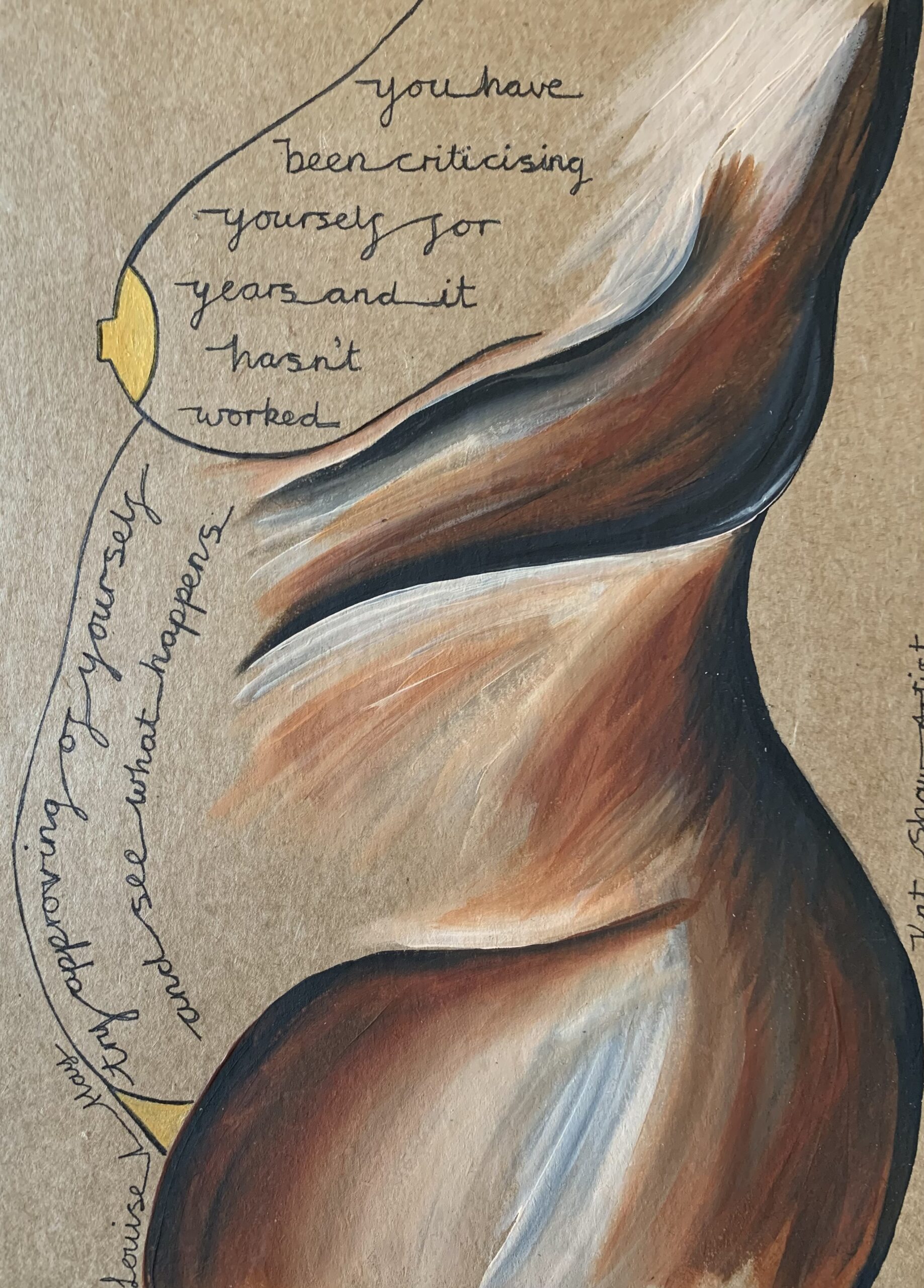
In 1980, Louise moved back to Southern California and began documenting her ideas and workshops, from which the hugely successful You Can Heal Your Life and Heal Your Body: The Mental Causes for Physical Illness and the Metaphysical Way to Overcome Them emerged in 1984. These titles were published by her newly-established publishing house, Hay House, which has gone on to publish books by Deepak Chopra, Doreen Virtue, and Wayne Dyer.
In 1985, she founded support groups for people with HIV or AIDS, called Hayrides, which soon expanded to 800-strong gatherings. This work inspired her to write The AIDS Book: Creating a Positive Approach. In the same year, she also established the Hay Foundation to support charities concerned with the environment and people in need. These endeavours brought her to public attention, leading to appearances on 'The Oprah Winfrey Show' and 'Donahue' in 1988.
You Can Heal Your Life has been a worldwide bestseller, translated into over 30 languages. A film of the same name, focusing on Hay’s life and teachings, was released in 2008. Hay died in 2017, aged 90.[
“I stand on the sacrifices of a million women before me.”
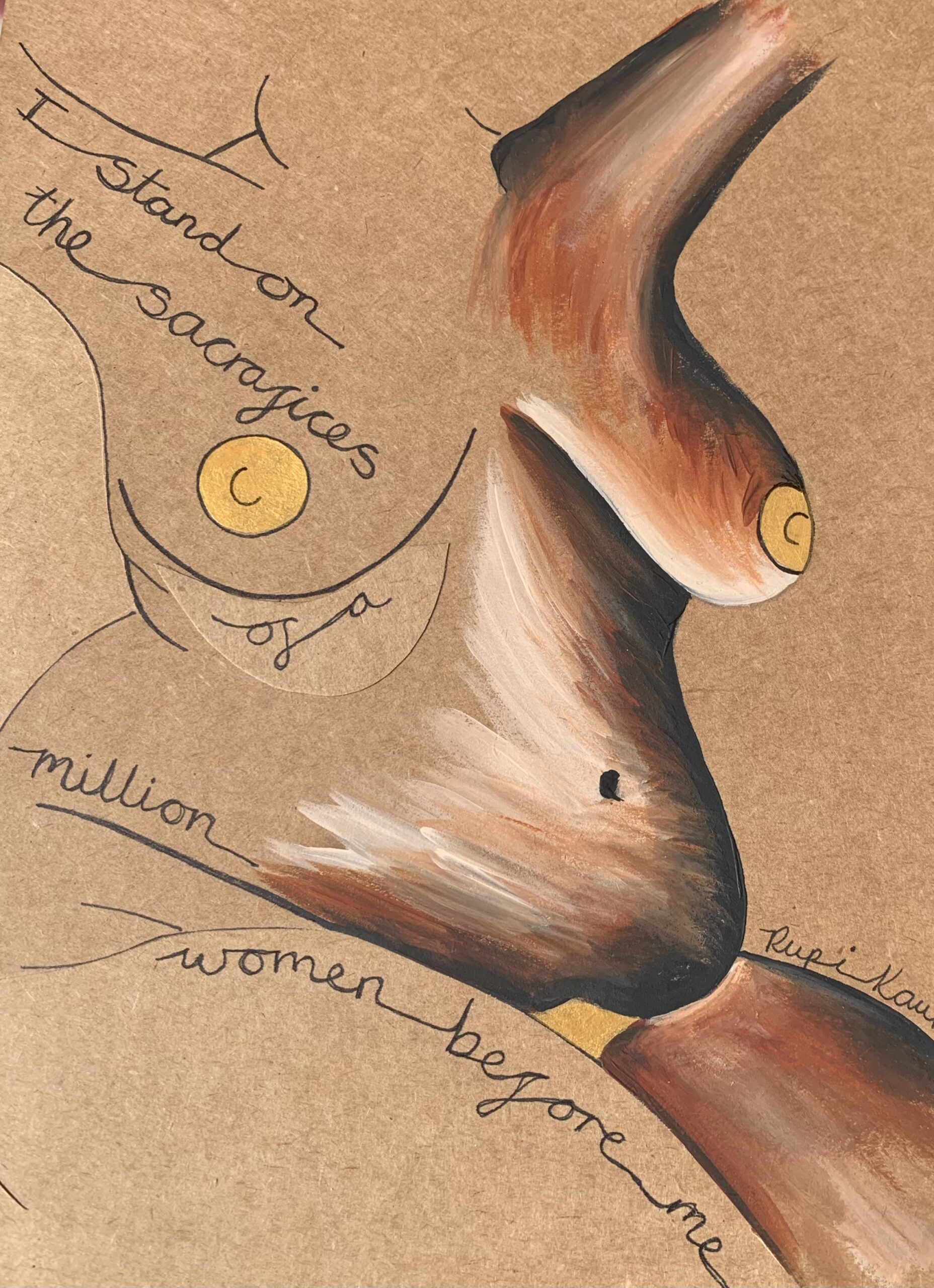
Rupi Kaur
Rupi Kaur is an Indian-born Canadian poet, illustrator, author and feminist; she is my ultimate favourite and a huge influence in my life!
Kaur was born in 1992 in Punjabi, India, and moved to Canada with her family four years later. Her mother encouraged her artistic talent, but at seventeen, she began focusing on writing and performing instead; she began performing and publishing her poetry on Instagram and fame soon followed.
At 21, while still at university, she wrote, illustrated, and self-published her first poetry and prose collection, milk and honey (2014), which spent over a year on The New York Times Bestseller list. She exclusively uses lowercase in her work, as in Gurmukhi script, with no punctuation besides the period; this is to honour her culture, and because she "enjoys the equality of letters" - the style reflects her view of the world.
“What’s the greatest lesson a woman should learn? That since day one she’s already had everything she needs within herself. It’s the world that convinced her that she did not.”
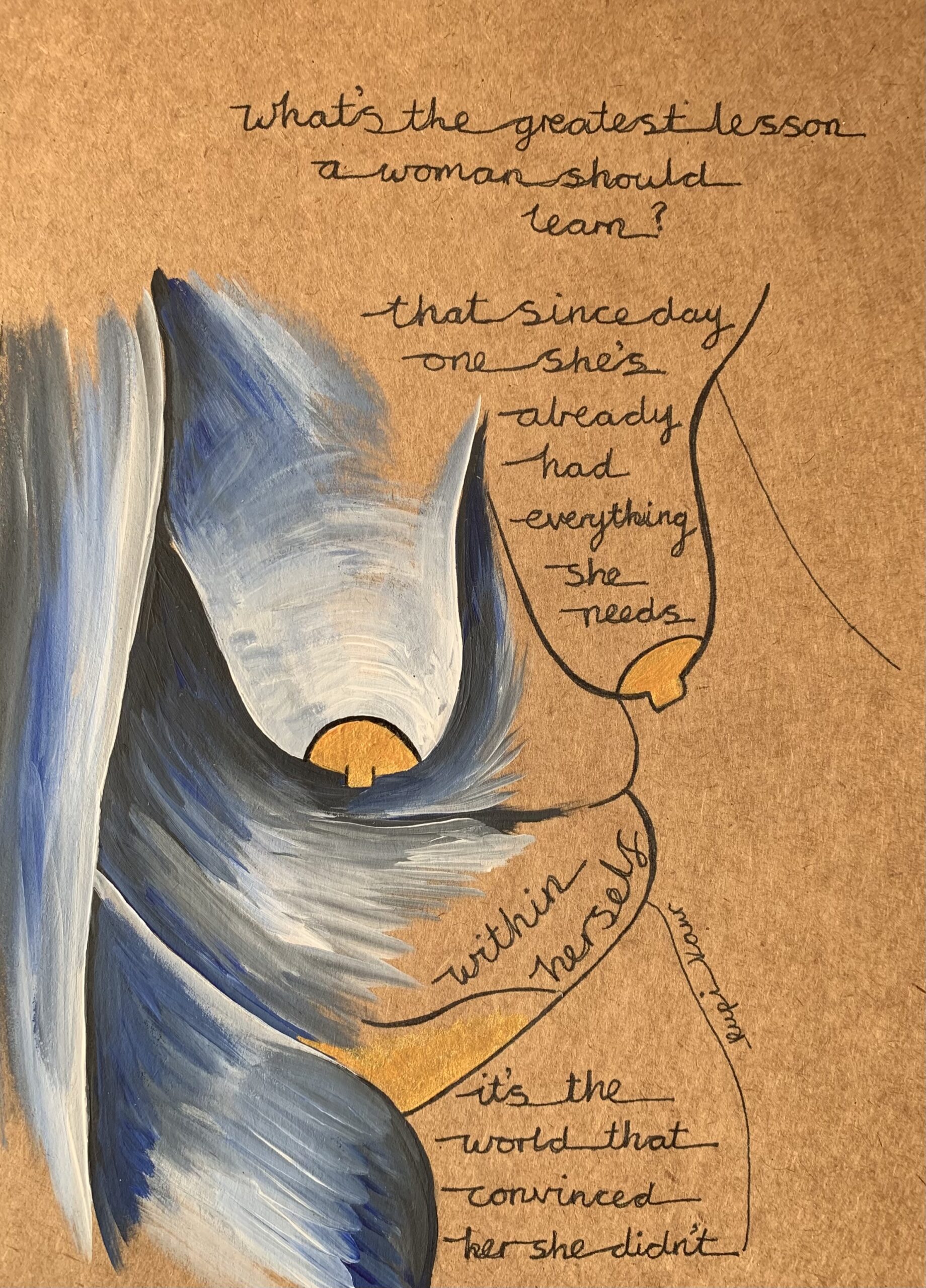
In 2015, she posted a series of photos featuring herself with menstrual blood on her clothes and sheets, as 'visual poetry' that defied social menstrual taboos. Instagram took down the images but later reinstated them and apologised when criticised for demonstrating the exact bias that the photo series was intended to highlight.
Kaur's second book, the sun and her flowers, was published in 2017, and led to her gaining a place in that year's BBC's 100 Women list. Her third poetry collection, home body, was released in 2020 and debuted at no.1 on bestseller lists worldwide. Her work touches on topics including violence, love, loss, immigration, abuse and femininity. She says she is inspired by other people's stories and experiences, and by authors such as Anaïs Nin, Virginia Woolf and Warsan Shire.
Kaur is now involved in film production too, and live shows are 'poetic theatrical experiences' sprinkled with her unique comic touches.
“I am mine before I am anyone else’s.”

Nayyirah Waheed
Nayyirah Waheed is a US poet and author. I have included her in this project as I think that these words of hers - “I am mine before I am anyone else’s” - are life changing.
Waheed was born in 1979 started writing at eleven, inspired by a school assignment to write a poem for a community newspaper. Not much else is known about her early life, as she is a very private person, often described as quiet, reclusive or mysterious. However, she has also been described as “perhaps the most famous poet on Instagram,” and has gathered a loyal following on social media.
Her evocative and powerful work cannot only be found on Instagram, though; her short-form, minimalistic poetry can now be found in two self-published books. The first, salt., was published in 2013, and covers themes such as racism, misogyny, self-love, self-empowerment, feminism and xenophobia. Her second, nejma, published in 2014, covers similar themes, but some readers feel it has a more personal atmosphere.
Waheed's poetry has been praised by critics and she cites the works of Sonia Sanchez and Maya Angelou as influential in her writing. She has used her platform to speak about social issues and advocate for marginalised communities, and women all over the world find her work resonates strongly with them.
















